AC Milan were held to a 2-2 draw with Bologna at San Siro after conceding a stoppage-time penalty. The Rossoneri missed two spot-kicks themselves during the course of the game, making it a night full of regret and two dropped points.
It was the visitors who took the lead in the 29th minute, when much-talked about Joshua Zirkzee struck through the legs of Mike Maignan following a Bologna breakaway. Ten-minutes later, Milan were awarded a penalty for an adjudged ‘high-footed’ foul on Simon Kjær.
Bologna felt that aggrieved by the referee’s decision that head coach Thiago Motta was dismissed before the spot-kick was taken, and then another member of the backroom staff was sent off quickly after Olivier Giroud’s tame effort had been saved by Łukasz Skorupski.
The hosts equalised proceedings on the stroke of half-time through Ruben Loftus-Cheek, the English midfielders fourth of the season and first at home. In the second half, Milan had the opportunity to take the lead in the 74th minute, but Theo Hernández’s penalty hit the post and then his attempt to convert the immediate rebound was ruled out, as against the rules.
Milan did go ahead in the 83rd minute though, with a Loftus-Cheek second, but it still wasn’t enough to seal victory. Bologna leveled the match in the 92nd minute, showing their opponents how to convert from twelve yards.
In an entertaining and eventful game, here’s @Tactics_Tweets tactical observations.
Bologna’s build-up
In the pre-match press conference, Pioli referenced his team’s typical out of possession approach: “The way we work in the defensive phase we would like our midfielders to work hard on their midfielders and our two central defenders on their strikers.”
But in this fixture against Thiago Motta’s side, Milan had a new issue to face without the ball: who would pick up the Bologna centre-backs when they advanced forward?
A major aspect of Bologna’s possession-based style is the team’s build-up play. In addition to having the third highest possession share in Serie A this season (56.6%), the visitors have also completed more passes in their own half than any other Italian top flight side (4,938).
Motta coaches his team to maintain patient possession in their own half and then uses player movements to create numerical superiority and positional rotations to execute third-man combinations.
A recurring rotation Bologna deploys during build-up phases is their centre-backs advancing into midfield areas (and beyond). Timing plays a crucial role in the effectiveness of this tactic, as it involves coordination with the dynamic midfield trio of Remo Freuler, Lewis Ferguson and Michel Aebischer who are constantly on the move to destablise the opposition’s organisation.
Against Milan, Bologna showcased multiple examples of this tactic in practice and the upsides it can produce. Namely bypassing the first-lines of opposition pressure and progressing the ball upfield. However, an ongoing theme of the match was how Bologna did not always capitalise upon their initial build-up progression.
The away team were effective in getting the ball through the thirds but often failed to generate the direct subsequent threat in the final third. The following examples will highlight the varied reasons for this. Plus, showcase the complexities Milan had to deal with out of possession.
Let’s start in the 4th minute, where Bologna have deep-possession. Ahead of play there are multiple off-ball movements happening simultaneously for the visiting team; the right-back and right winger interchanging and two of their central midfielders rotating to disorientate the Milan midfield.
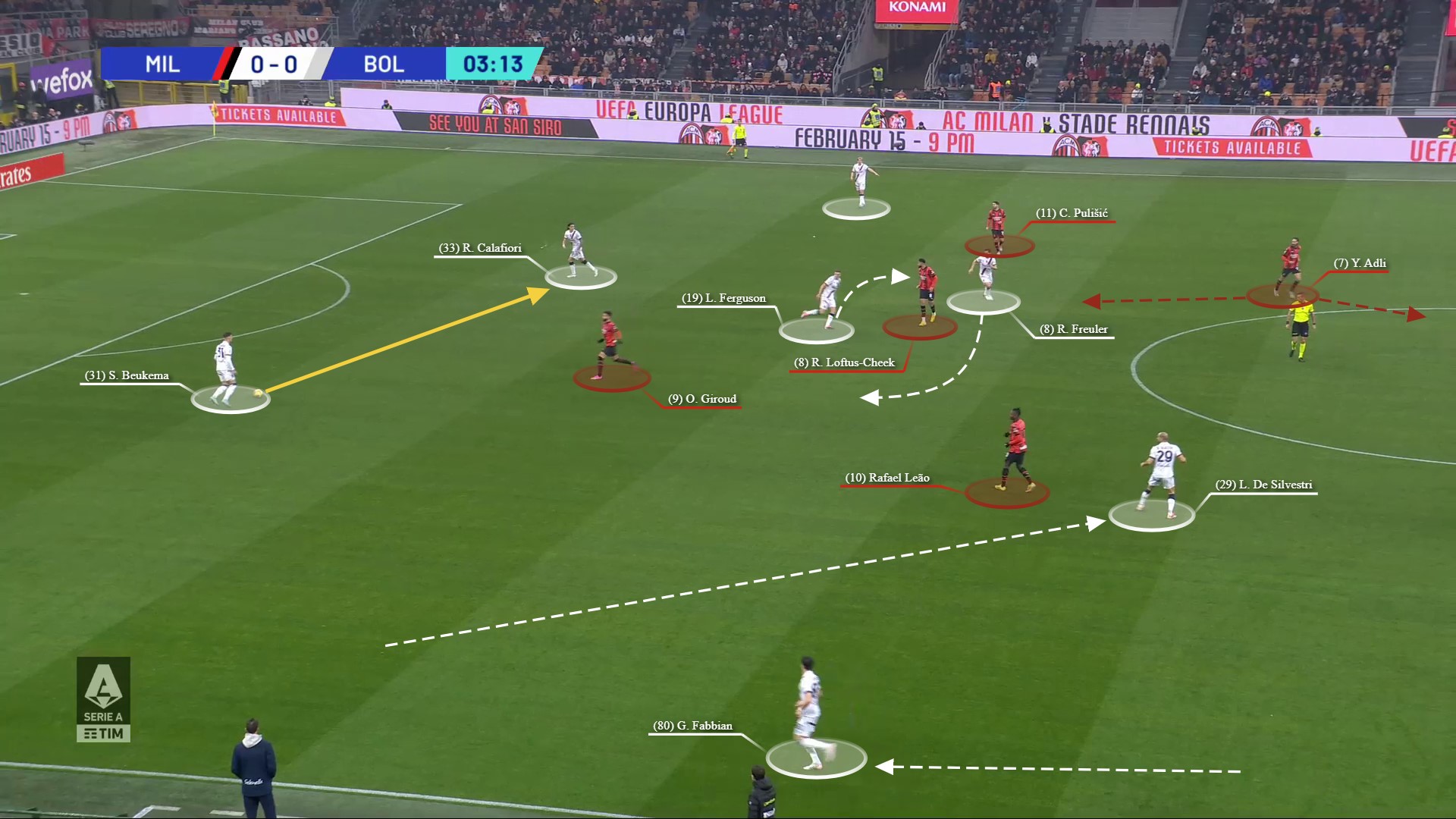
Bologna maintained possession amongst their backline, and less than 10 seconds later, the picture below looks a completely different story. This visual also helps depict part of Milan’s defensive plan – and the questions it was asked by the opposition.
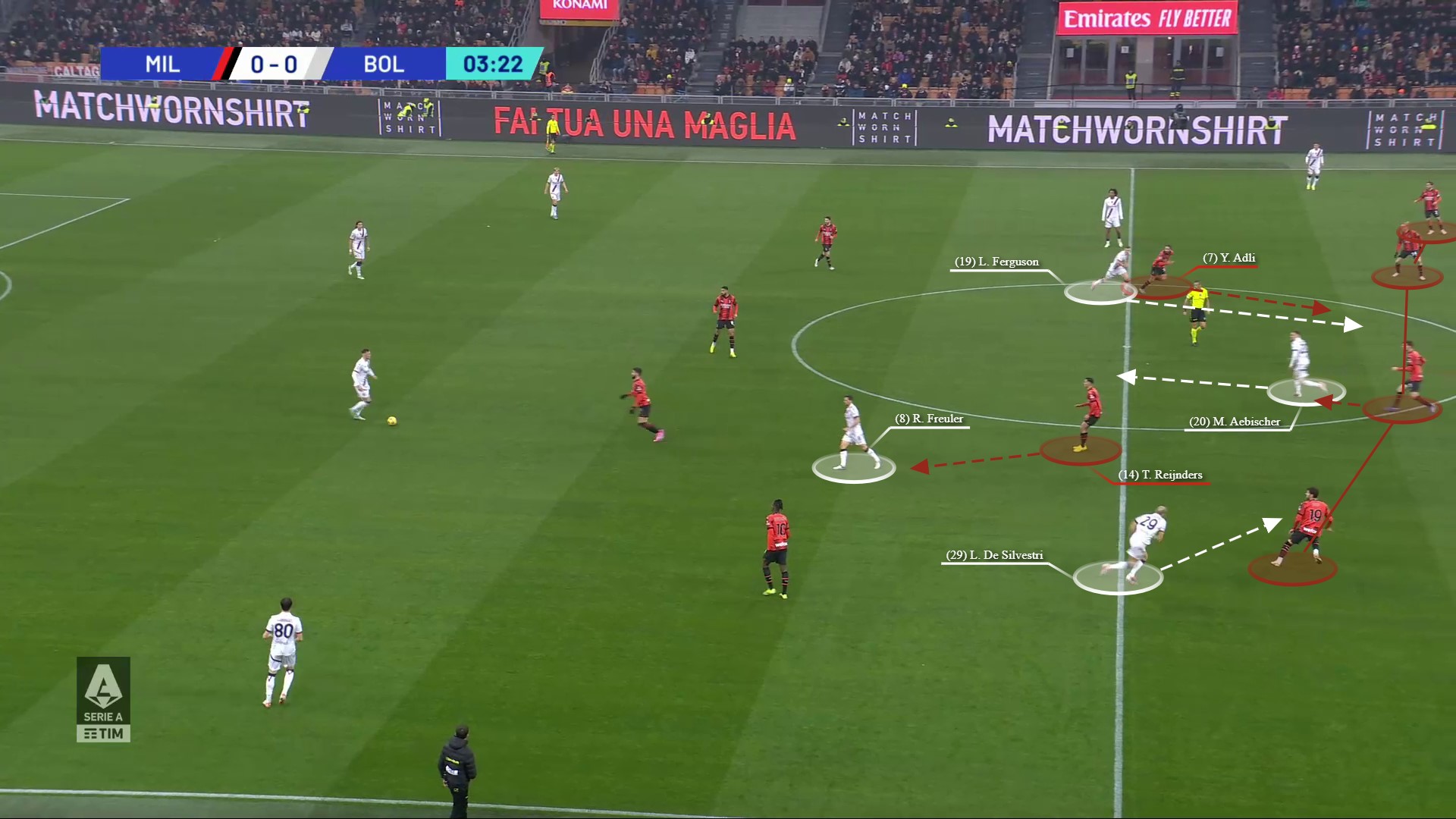
As seen above, when Milan engaged higher up the pitch, Loftus-Cheek typically pushed up alongside Giroud to form a situational 4-4-2 formation.
This duo acted as the hosts first-line of defence meaning they were responsible for engaging the opposition centre-backs and blocking vertical passes into the Bologna midfield.
In the Milan midfield line, Yacine Adli and Tijjani Reijnders had the unenviable task of trying to track Bologna’s midfielders and protect central zones. This resulted in the pairing constantly being required (or baited) to shuttle laterally, and forwards and backwards – as the prior image demonstrates.
In the Milan backline, their full-backs first priority was Bologna’s wide attackers (or whoever was occupying these spaces), and their two centre-backs needed to be constantly switched onto the whereabouts of Joshua Zirkzee – who had license to drop deeper to link play from back-to-front – and any of the Bologna midfielders (mainly Ferguson or Aebischer) taking up advanced positions (see Gabbia following Aebischer above).
Anyway, back to the action. Bologna worked the ball over towards their left flank. (For reference, note the positions of the three Milan midfielders (black cirlces) and how Ferguson and Aebischer have swapped again).
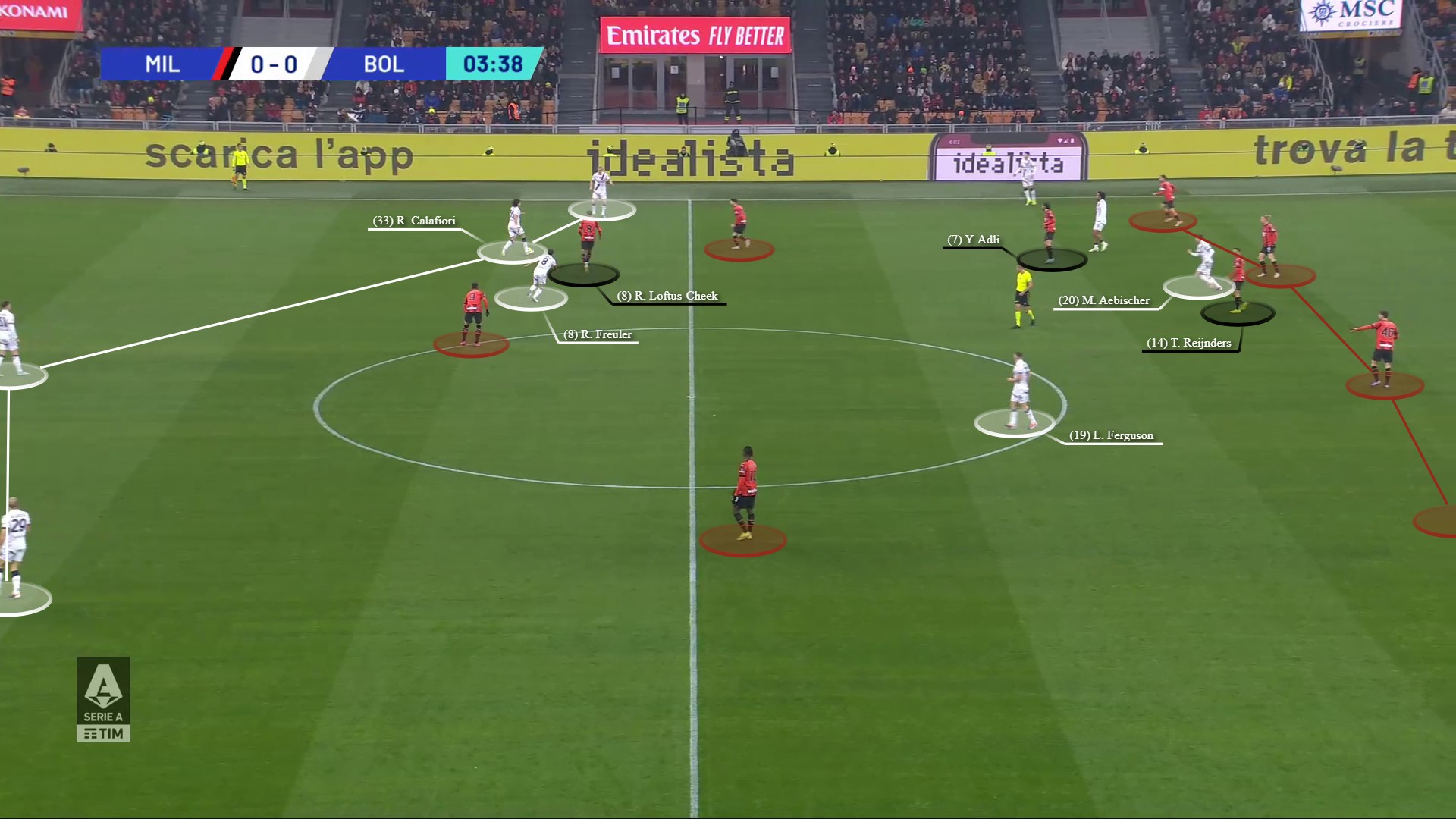
From the left flank, Bologna recycled the ball backwards to bait Milan further forwards and now you can see below how left centre-back, Riccardo Calafiori, has stepped into midfield.
With all nearby Milan players occupied elsewhere, Bologna were able to play a line-breaking pass into Calafiori and nearly bypass four opposition players.
However, the centre-back did not receive on the half-turn and instead passed backwards again. From here, left-back, Kristiansen, attempted a pass into Zirkzee’s feet but Kjær’s close-marking enabled him to intercept and force a turnover which led to a Milan attacking transition.
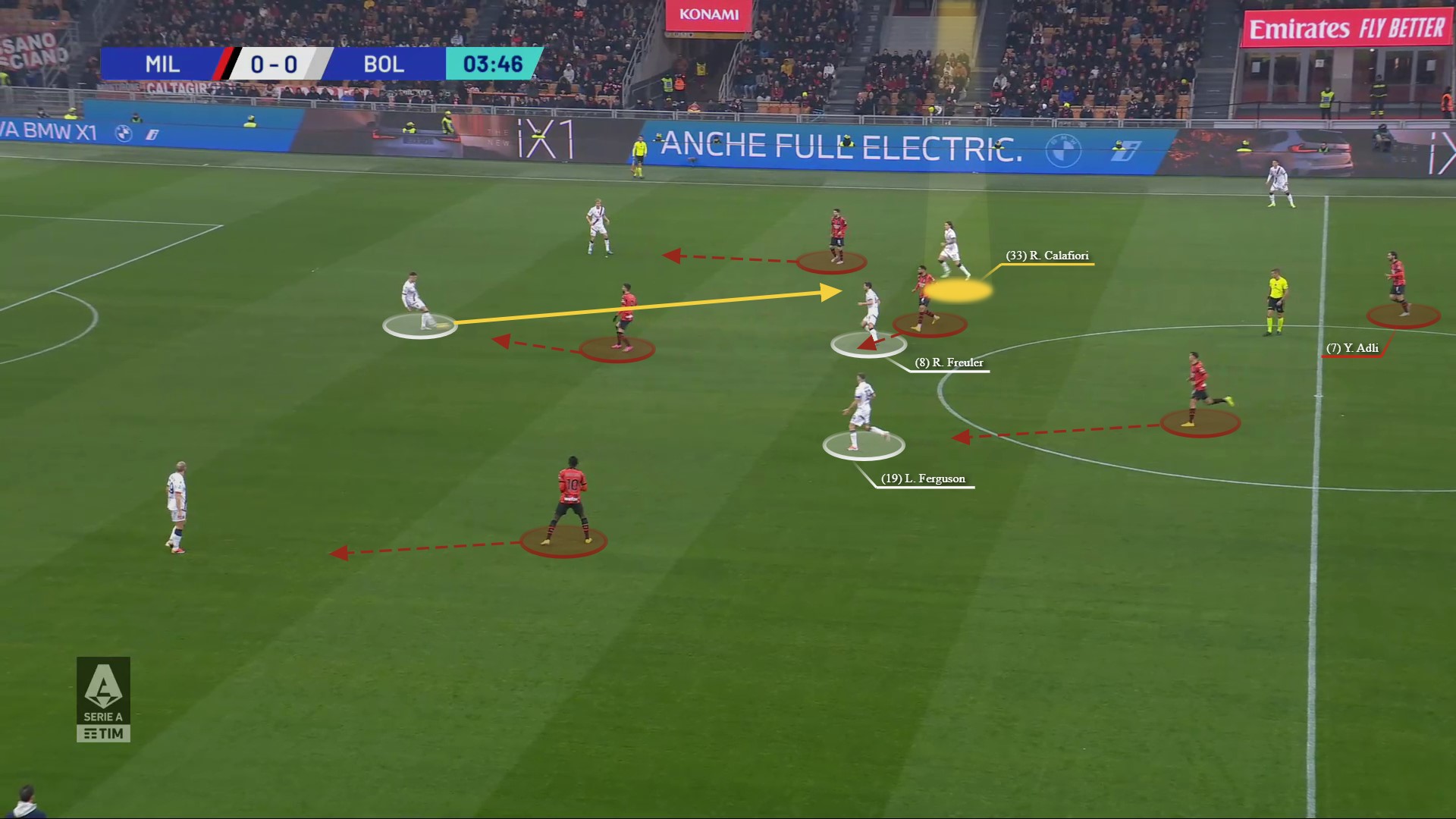
In the 7th minute, there was an example of Bologna in second phase build-up (i.e. middle third). The scene below shows Loftus-Cheek jumping up to support Giroud in the first-line, and in behind, Adli and Reijnders were orientated towards the Bologna central midfielders.
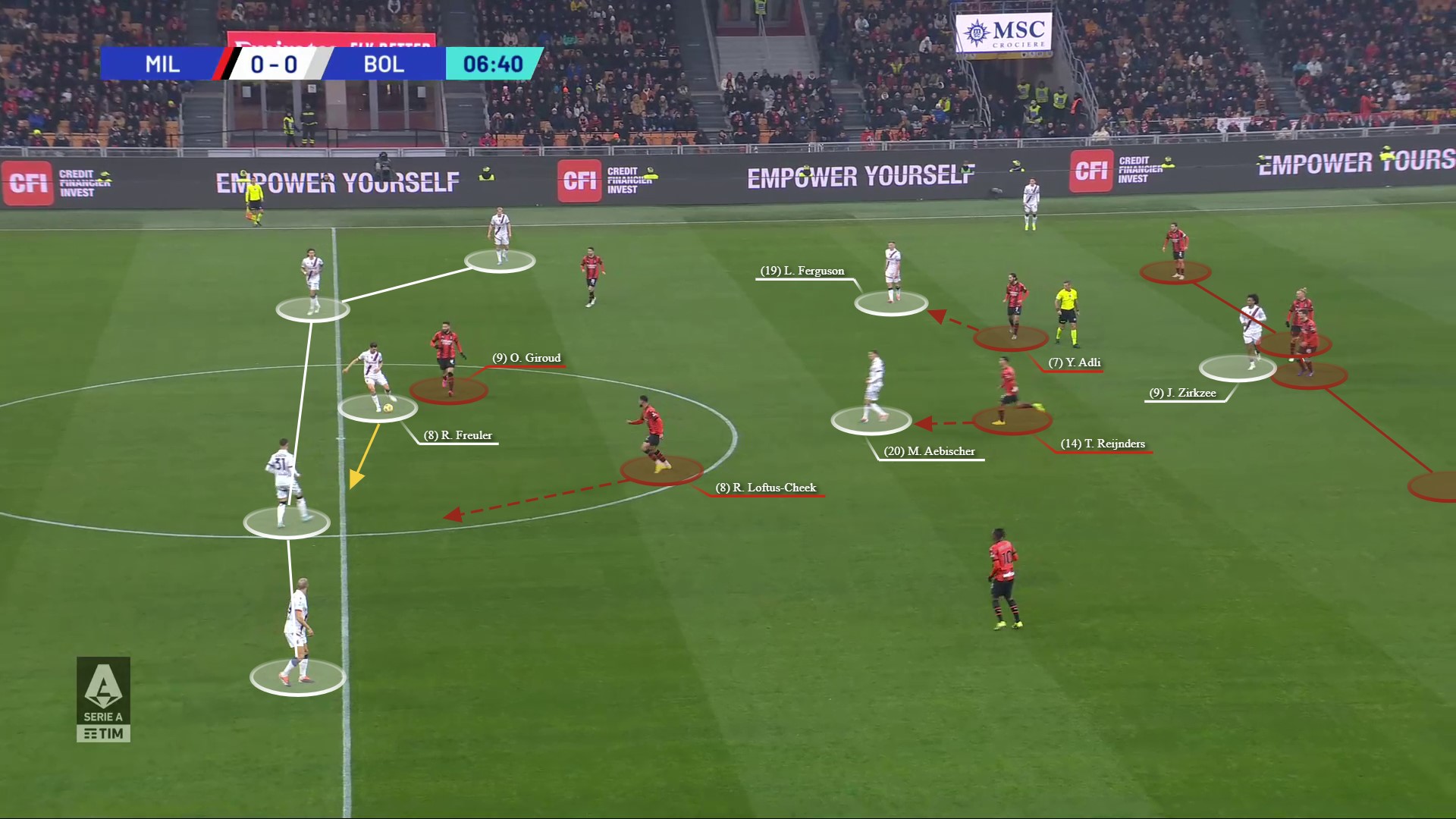
After receiving the ball, right centre-back, Beukema, angled a pass out wide to his left-back which Pulisic was anticipating. However, it was a decoy move, with instead a pass made into Calafiori who was making a forward movement.
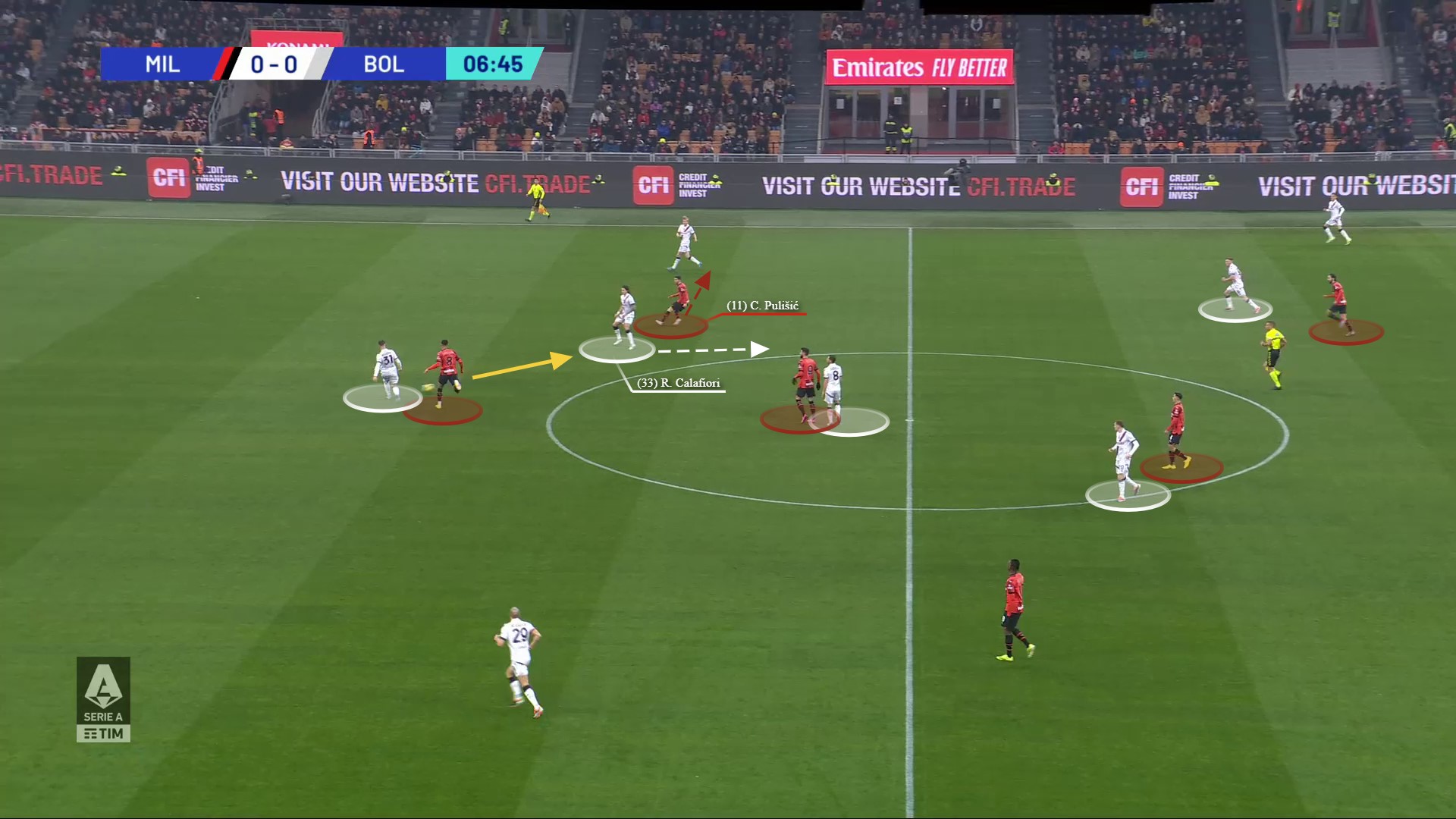
With the two Milan central midfielders pulled wide to stay near Ferguson and Aebischer, Calafiori had space to carry into. However, the centre-back overran the ball, and Milan regained possession.
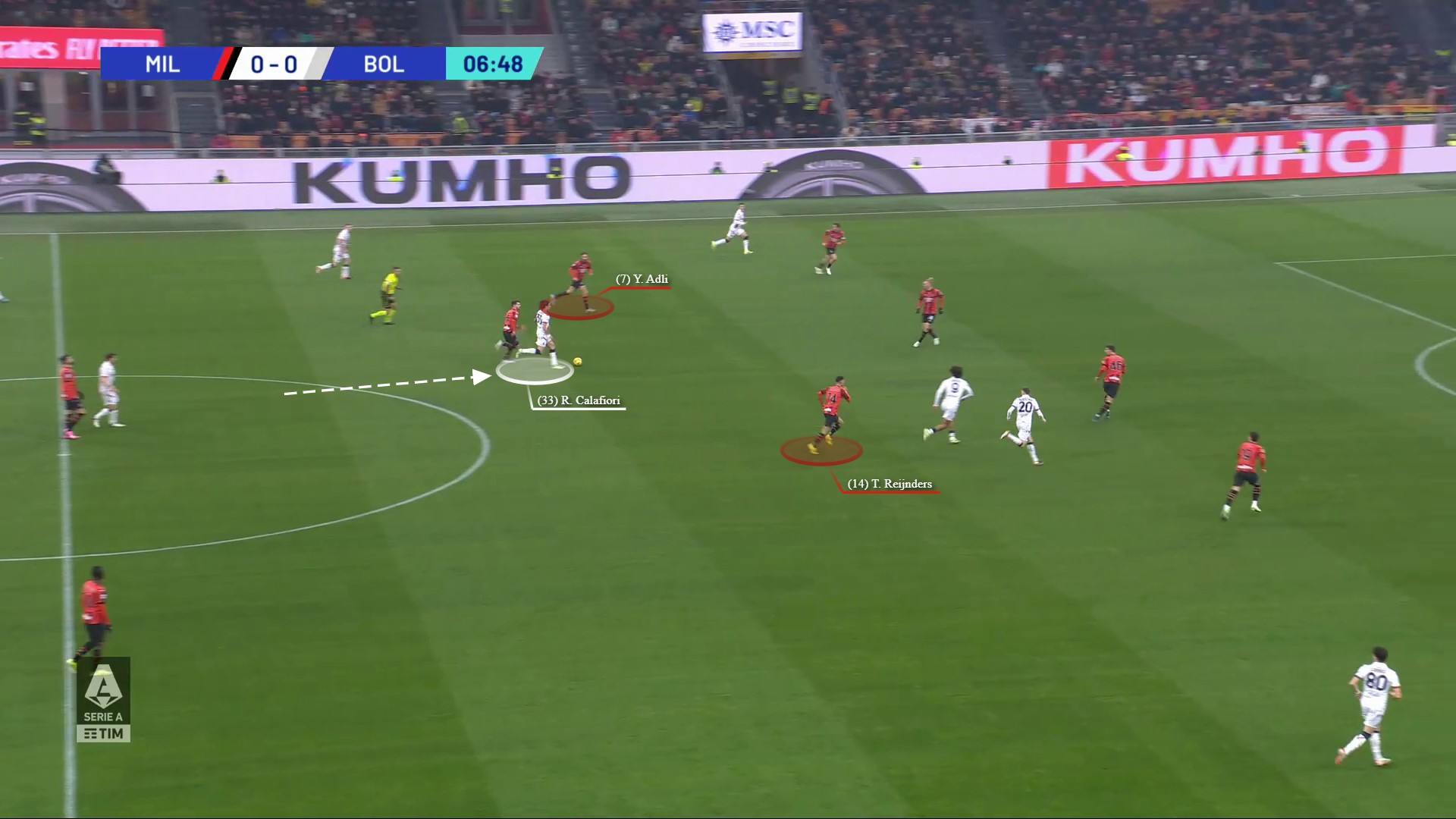
Stepping into midfield was not only limited to Calafiori. Here in the 10th minute, Bologna were again in the opposition half and as such, the home team dropped into more of a 4-2-3-1 shape with Loftus-Cheek dropping deeper. Take a look at Beukema’s initial position…

…and then see how once he saw the space ahead – manufactured by Ferguson pulling Adli forward, Aebischer pinning Reijnders deeper and Freuler dragging Loftus-Cheek wider – he was equally happy to advance forward and receive the inside pass.
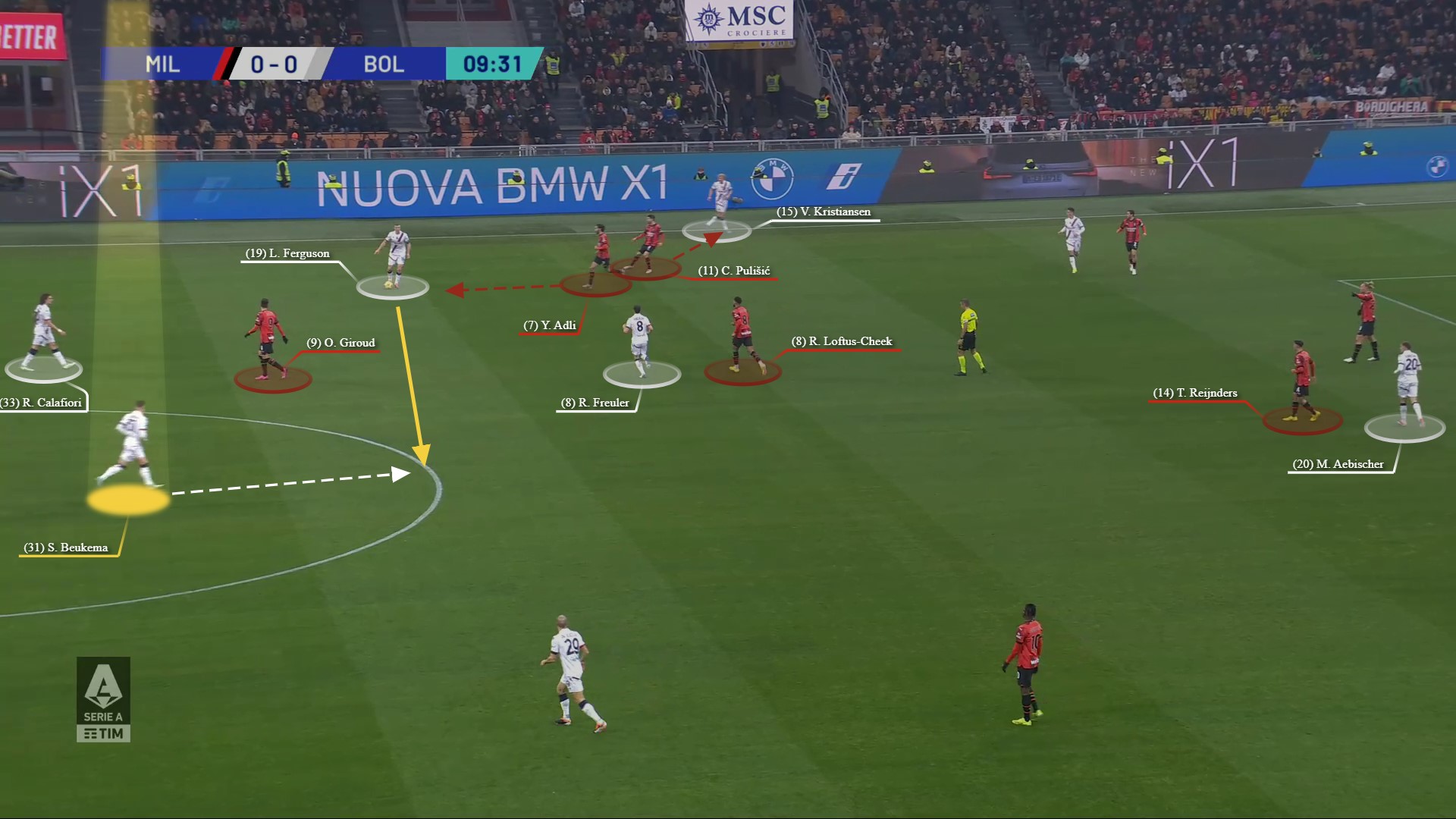
From here, Beukema passed into Zirkzee who had pulled away from the Milan backline. With Aebischer now occupying the two centre-backs, Reijnders was required to engage but the midfielder got chopped and Zirkzee let-off a shot which didn’t trouble Maignan.
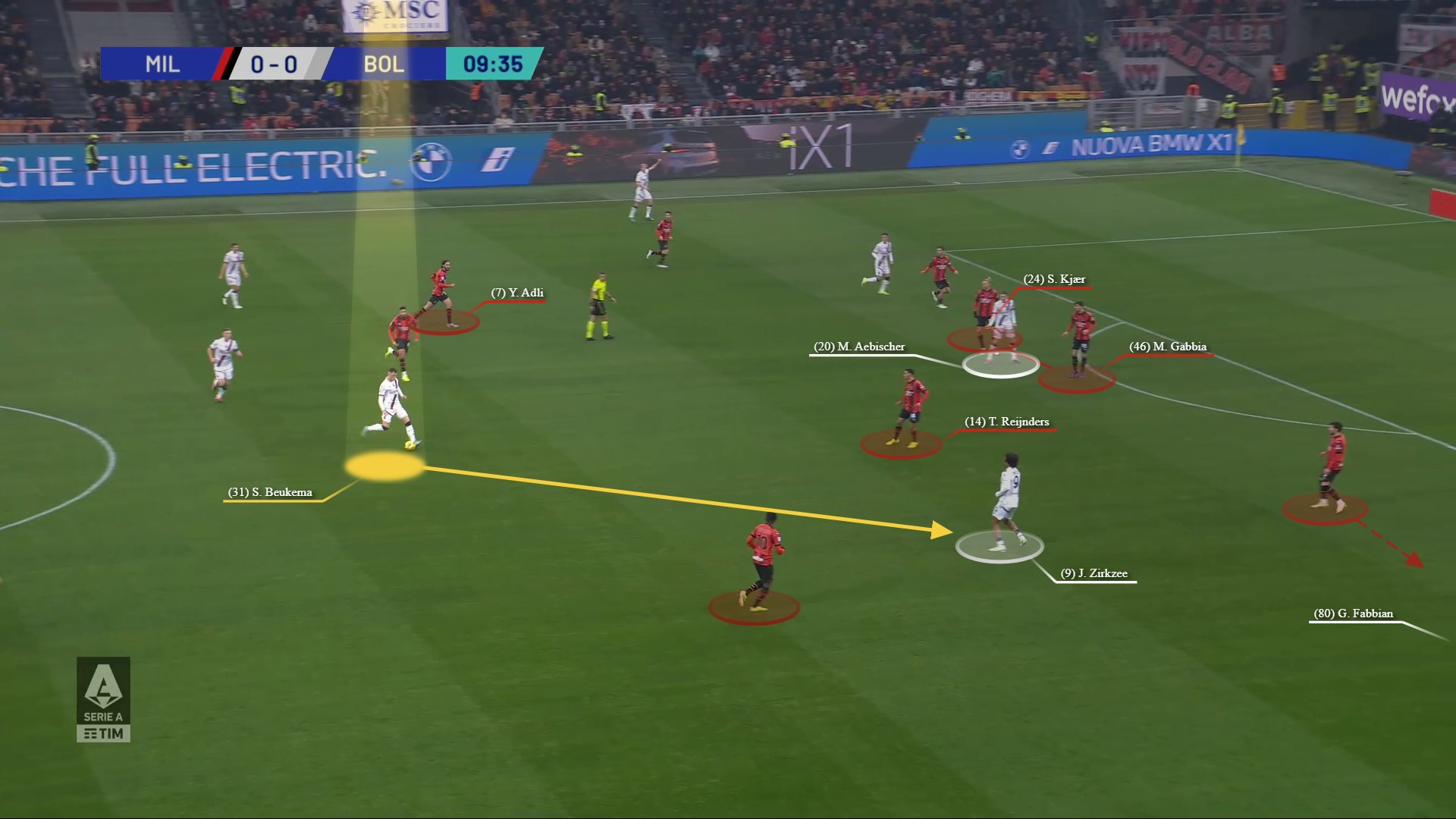
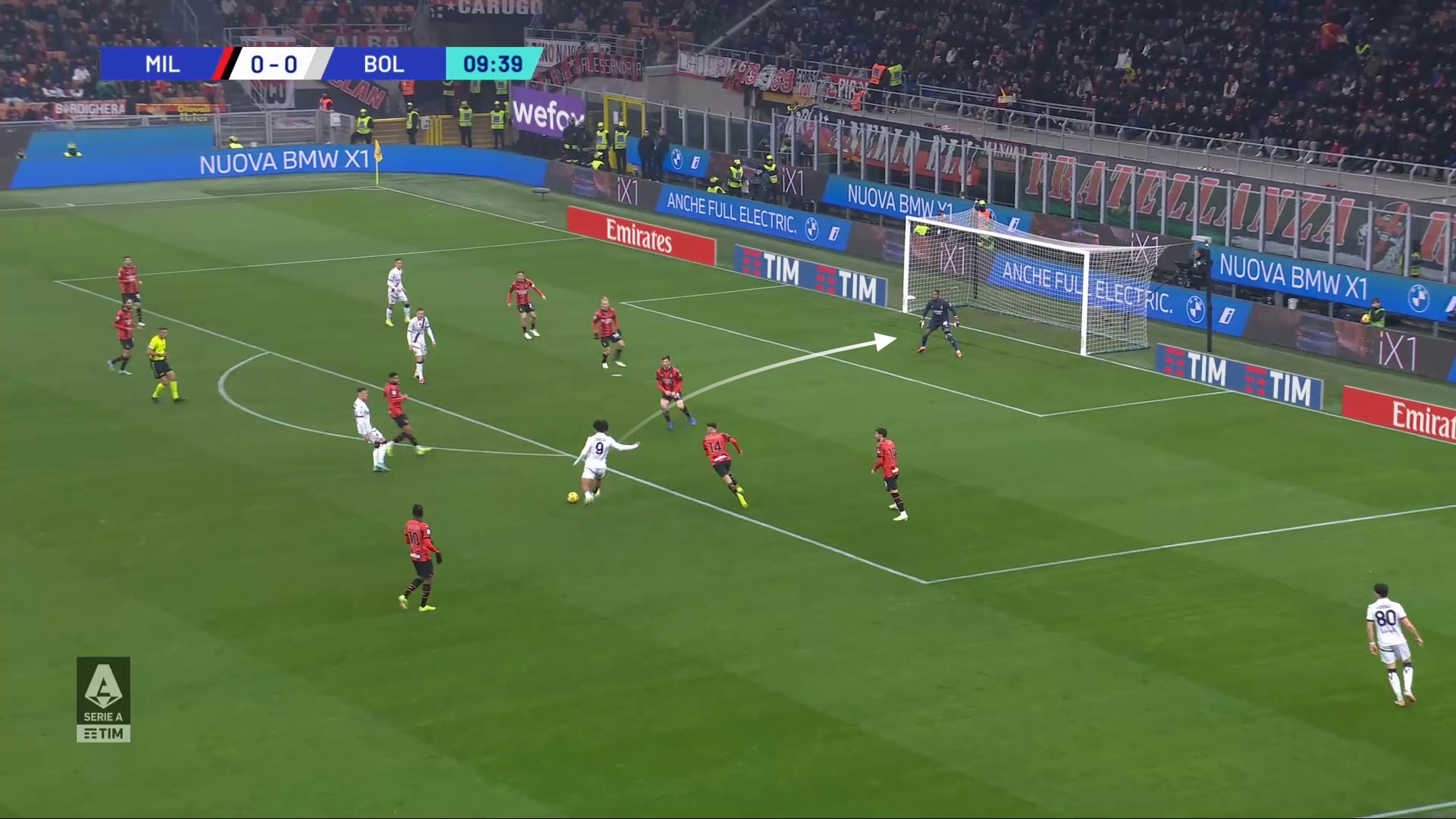
In another example of Bologa deep build-up, after playing out short from a goal kick, Skorupski was back in possession. On this occasion, Beukema had advanced, pulling Giroud deeper, and was signaling for a perhaps ambitious pass to be played into Aebischer.

Skorupski remained patient, as instructed, and instead played out towards the left flank. Below you can now see how Ferguson had dropped towards the ball meaning Adli needed to pass marking responsibilities of Freuler onto Loftus-Cheek.

Bologna stayed patient and recycled back towards their goalkeeper. Simultaneously, both Ferguson and Freuler pushed forward which dragged Adli with them, but importantly created separation from Loftus-Cheek.
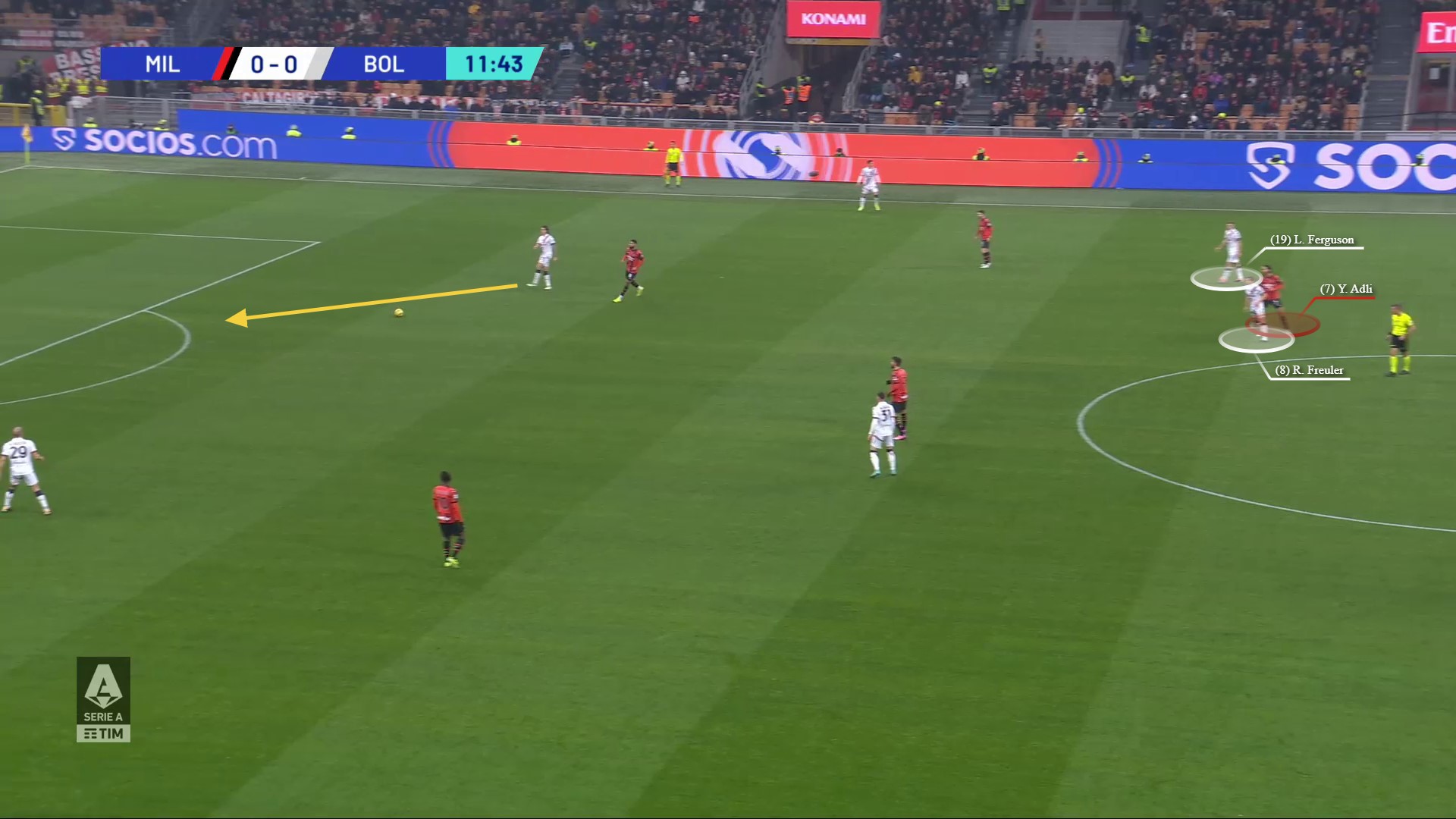
Another pass was made left towards Calafiori, and ahead Beukema and Freuler were interchanging. This rotation had a domino effect of a) dragging Adli away to free up Ferguson and b) caused confusion for Giroud and Loftus-Cheek about what to do (engage or use cover shadow, and if so, who).
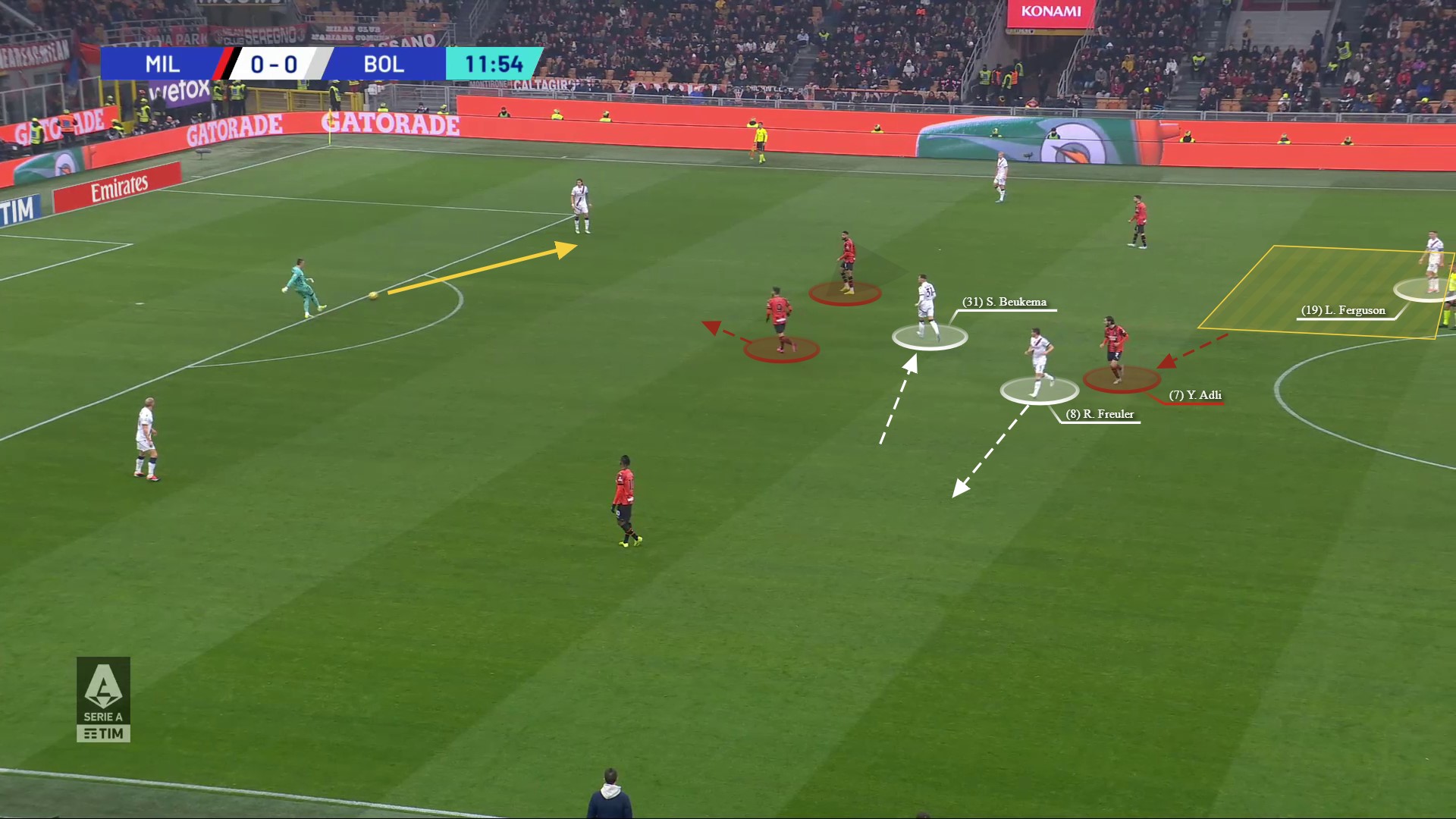
The outcome, a line-breaking pass was made into Ferguson, bypassing four Milan players in the process. As the Bologna midfielder was unmarked, Kjær had jumped out of the Milan backline in this action.
Seeing this, Kristiansen attempted a direct pass into his forward line – after receiving a lay-off from Ferguson – where there was a 3v3 opportunity.
However, the lay-off to Kristiansen and then his subsequent forward pass both lacked quality and Milan easily collected the loose ball.

On the 20-minute mark, Bologna had a spell of continuous possession for one minute and twenty seconds. It started with a goal kick, and again Beukema had advanced into midfield.
His positioning had dragged Giroud out of the Milan frontline which enabled Freuler to drop into the vacant space and execute a third-man pass to Calafiori.
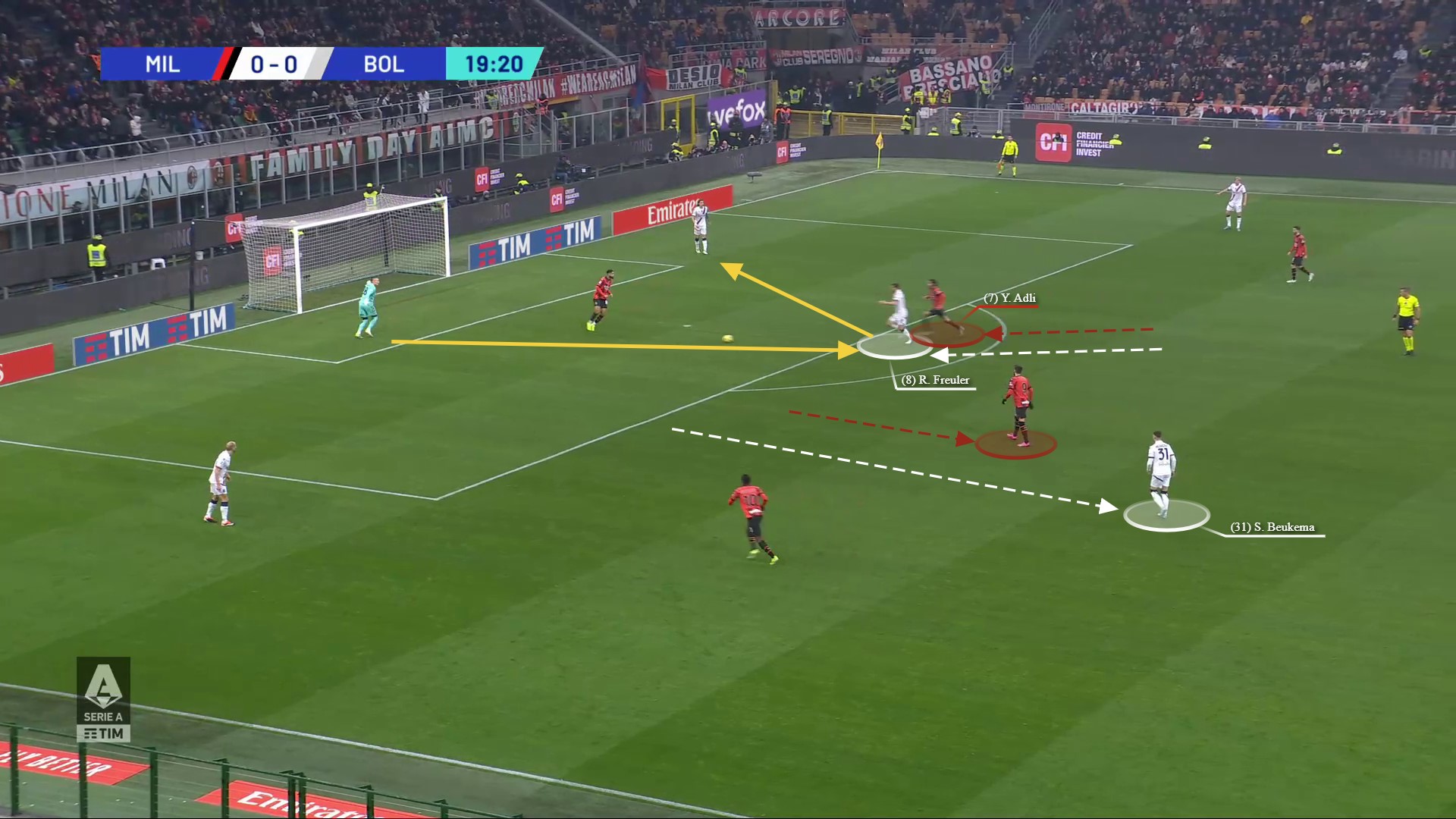
Beukema proved he was not simply a decoy player occupying space, however, by making a blindside run to receive a line-breaking pass.

However, the pass into Beukema lacked the required pace for him to receive on his front-foot and progress forward in his next action – potentially bypassing six Milan players. Instead, Bologna remained patient and recycled possession backwards.
Thirty seconds later, Bologna still had the ball but in an example of Milan’s pressing scheme, all ball-side options were covered meaning Bologna were this time actually forced backwards with no alternate nearby passing routes available.
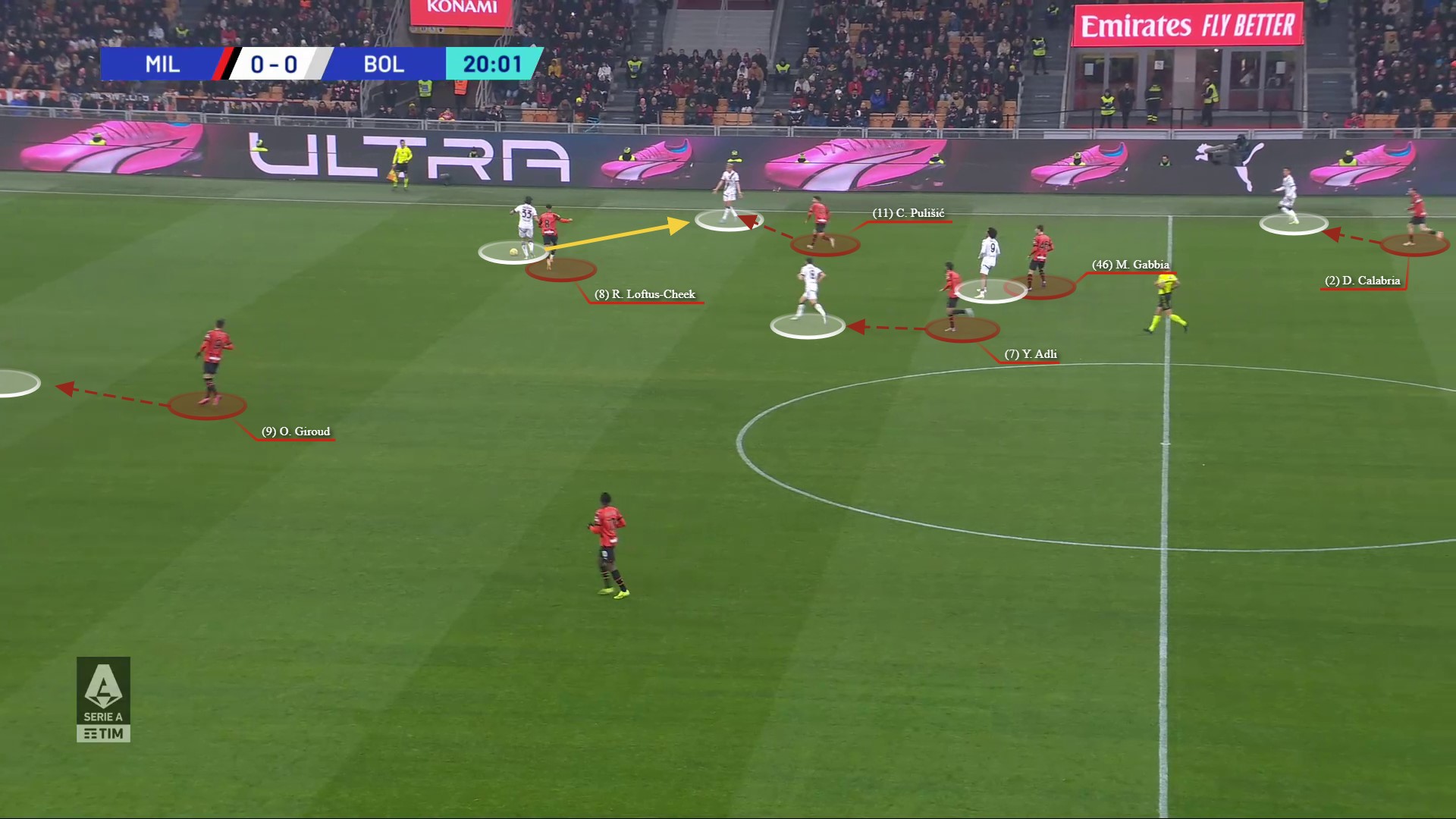
The passage of play did not end there though. Bologna restarted their build-up play, initially baiting their Milan forward but once their players realised they could not win the ball, they began to retreat…
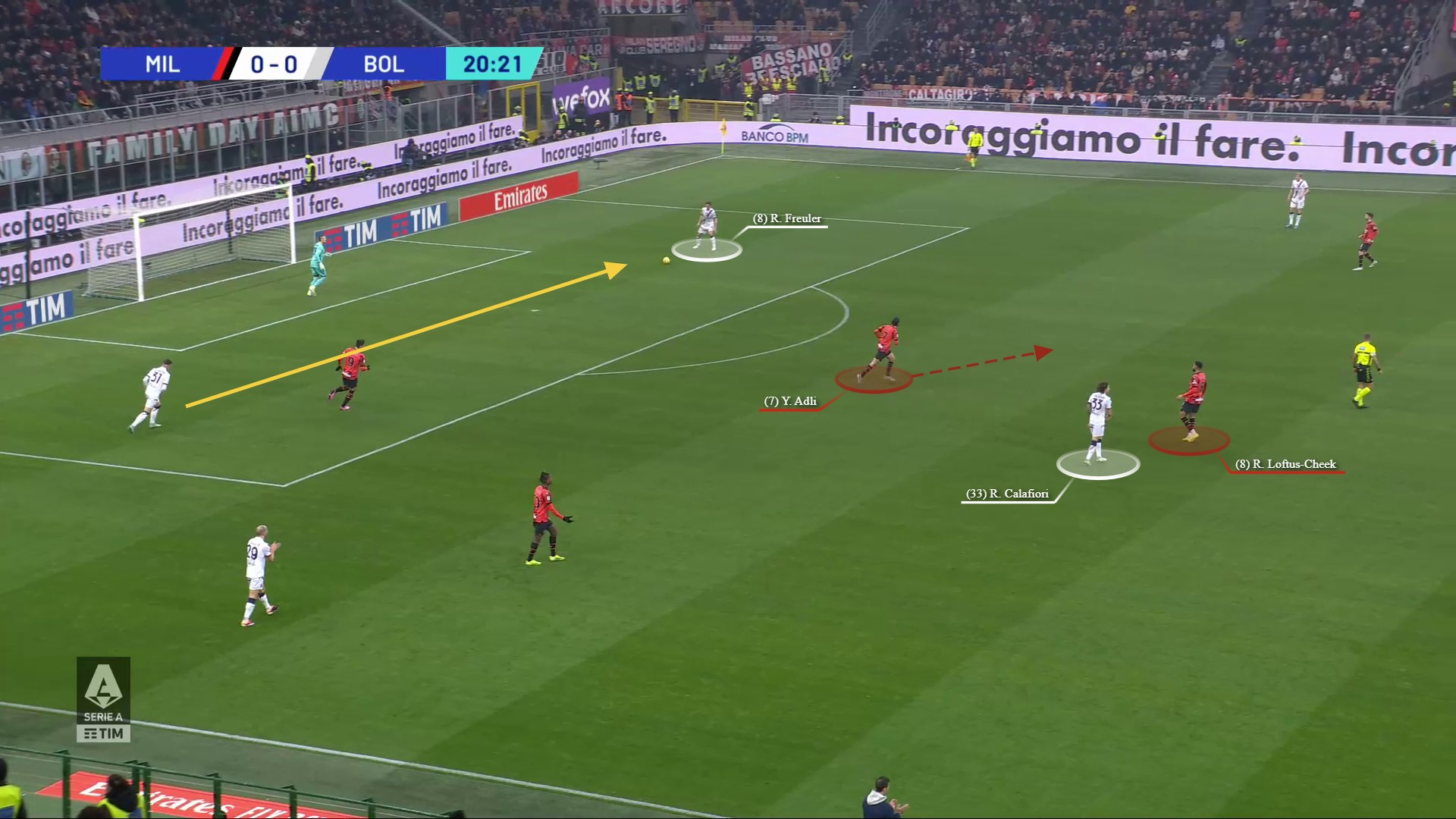
…which did allow Freuler to carry possession unopposed into the Milan half. However, with the hosts now reset in some semblance of structure they were prepared to engage the ball…
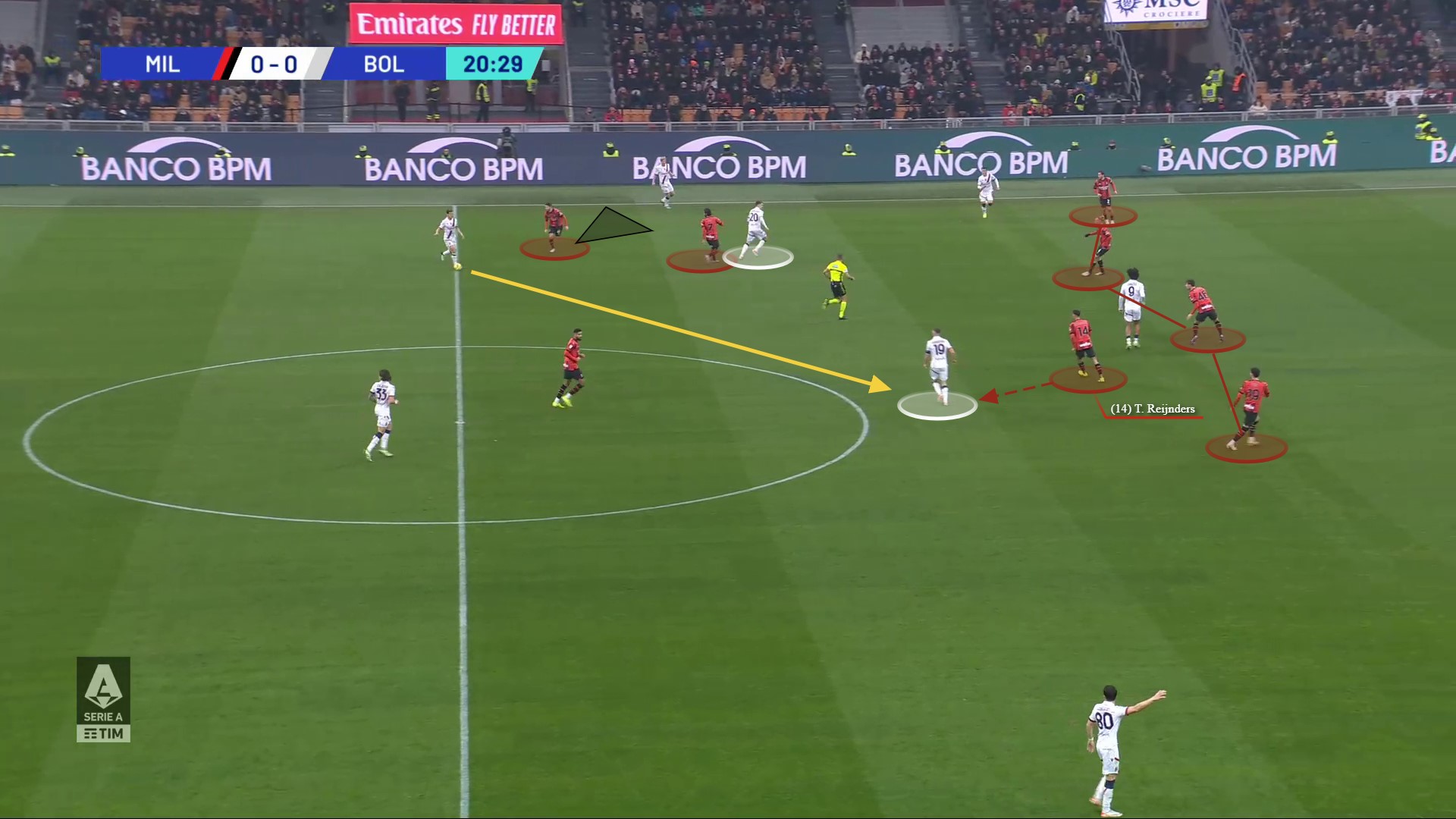
…and won a turnover (via Theo Hernández) at Bologna’s second attempt at a forward pass. In this specific instance, Milan went on the counterattack and generated a shot on goal.
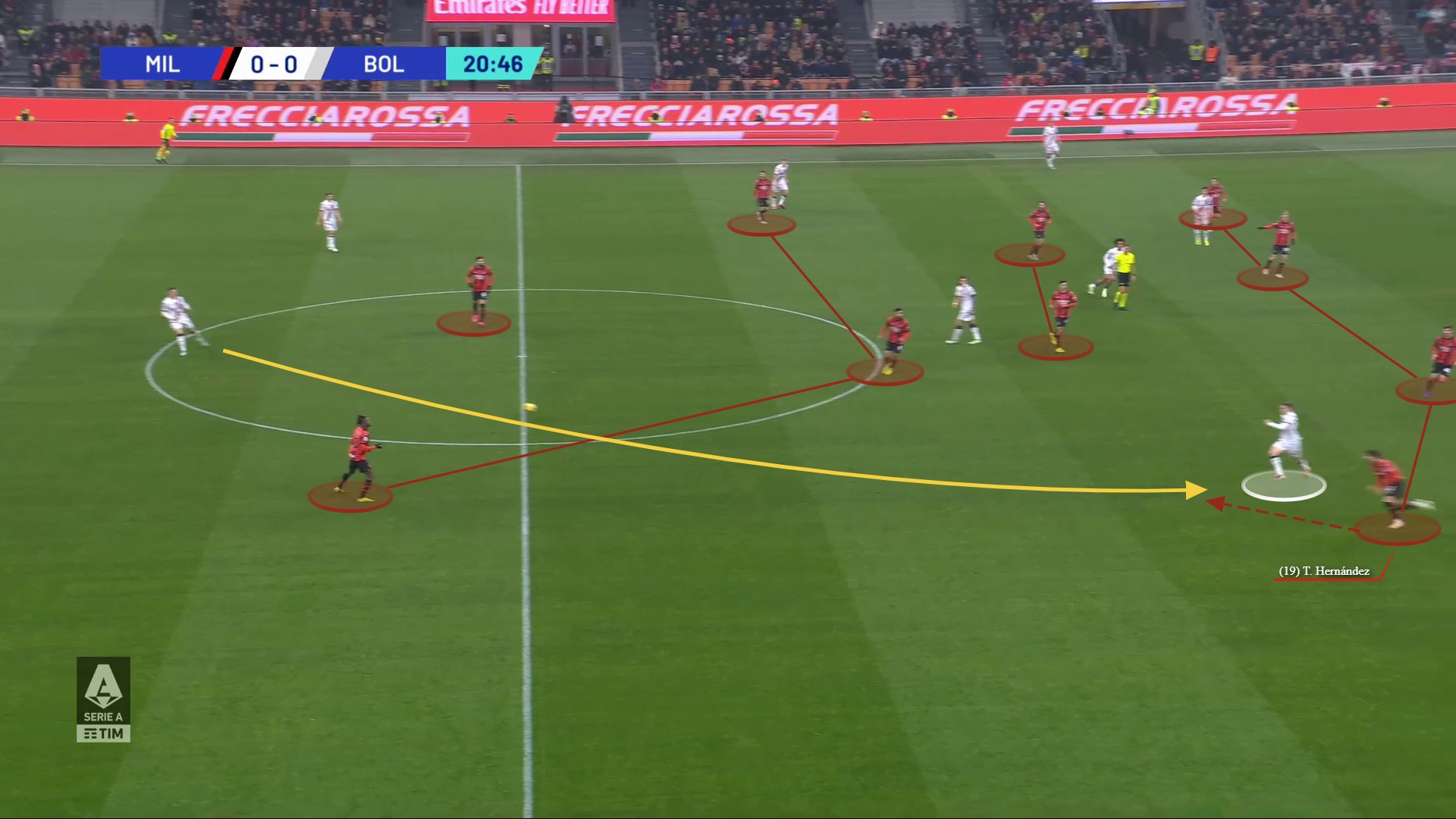
Bologna’s build-up rotations and centre-backs advancing continued to play their role in the second half. But after the break, it was predominantly Calafiori who had the license to join attacks.
Here’s an example in the 51st minute, where Calafiori’s forward run helped Bologna bypass five Milan opponents. From this move, the away side ended up working a shooting opportunity for Kristiansen from distance.
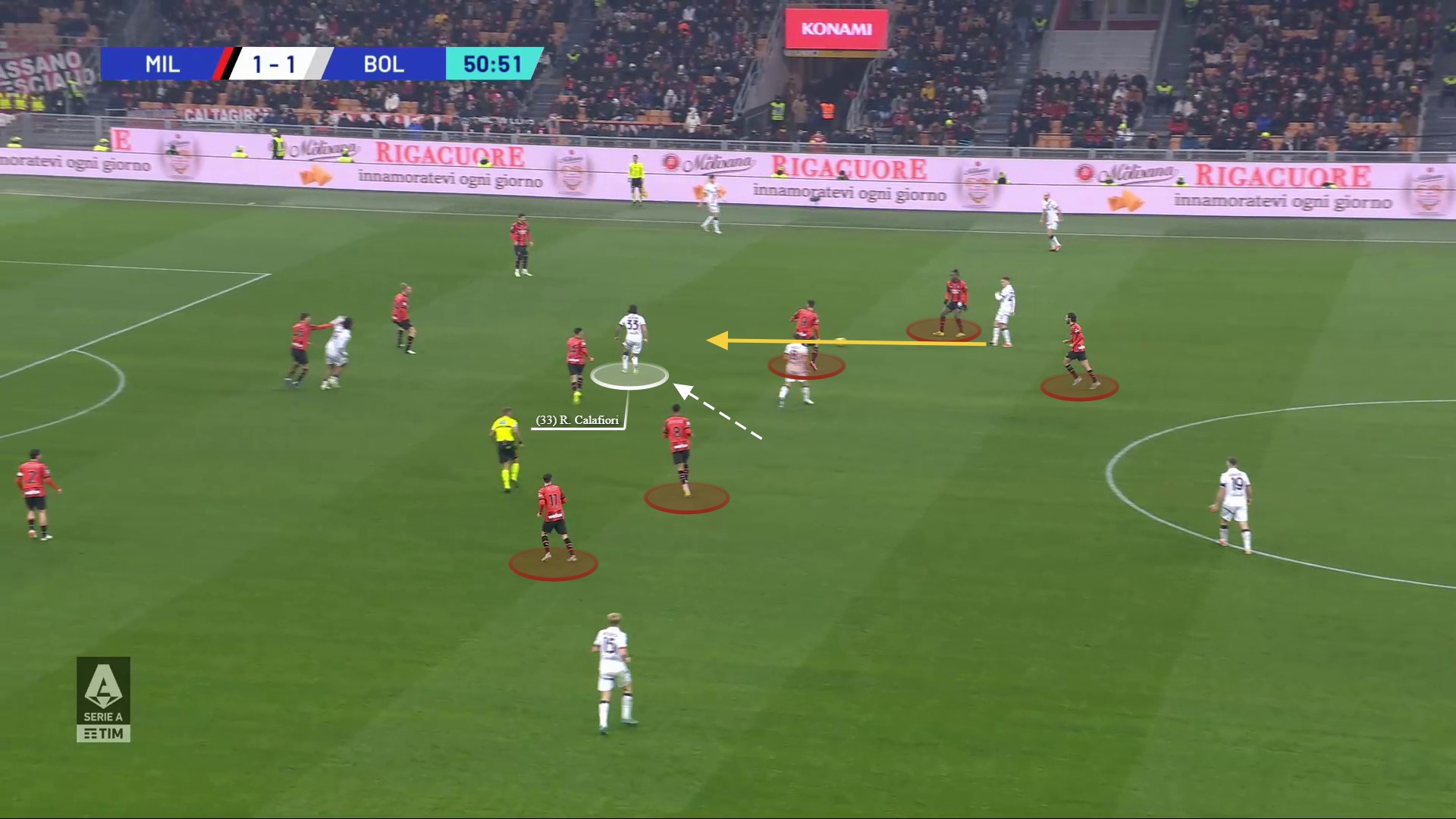
A few minutes later, Calafiori again added an extra Bologna body in the final third when he not only received a relay pass but carried forward towards the opposition backline before finding Zirkzee into feet. The young striker then swiveled before forcing two saves from Maignan in quick succession.
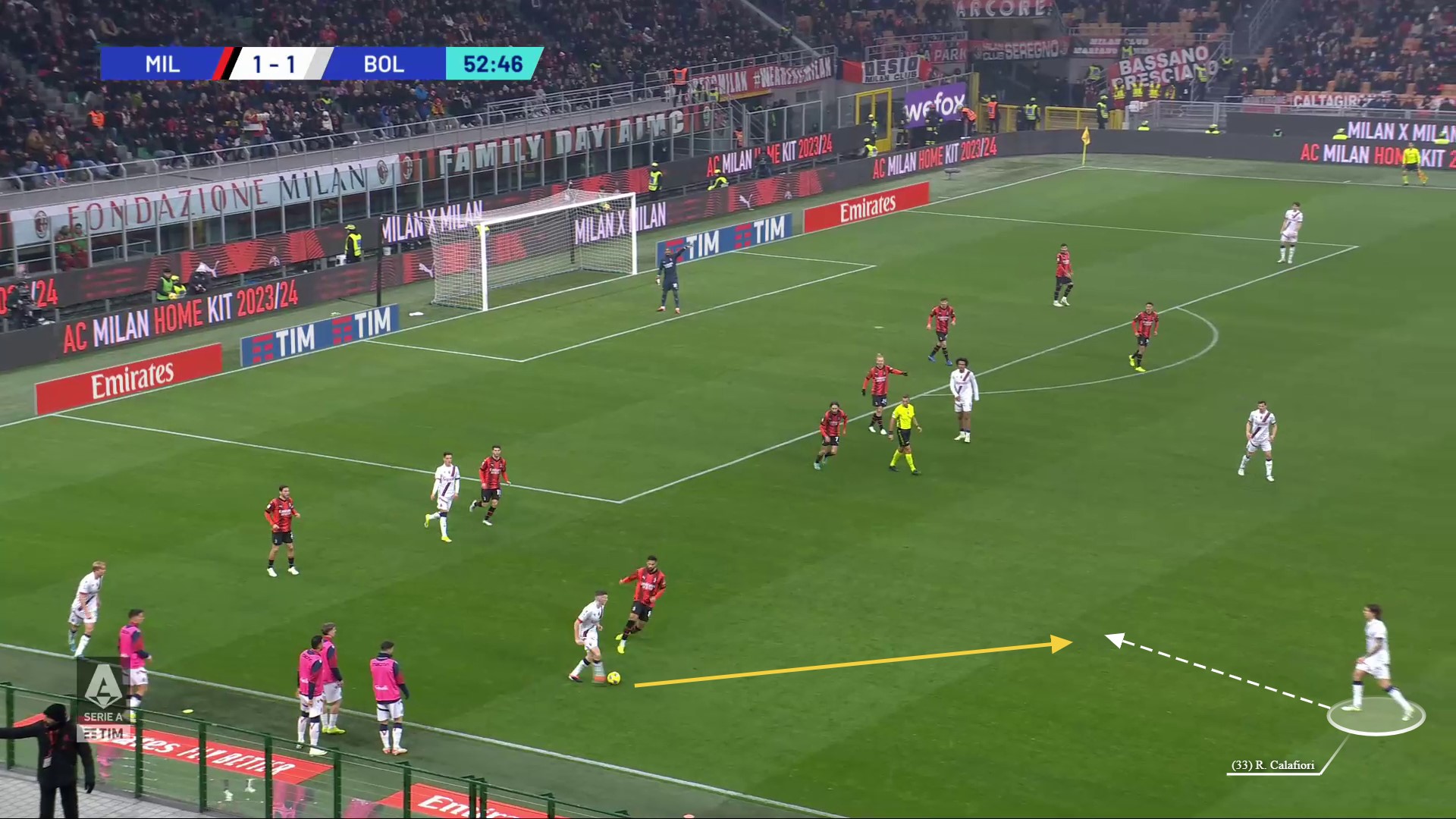

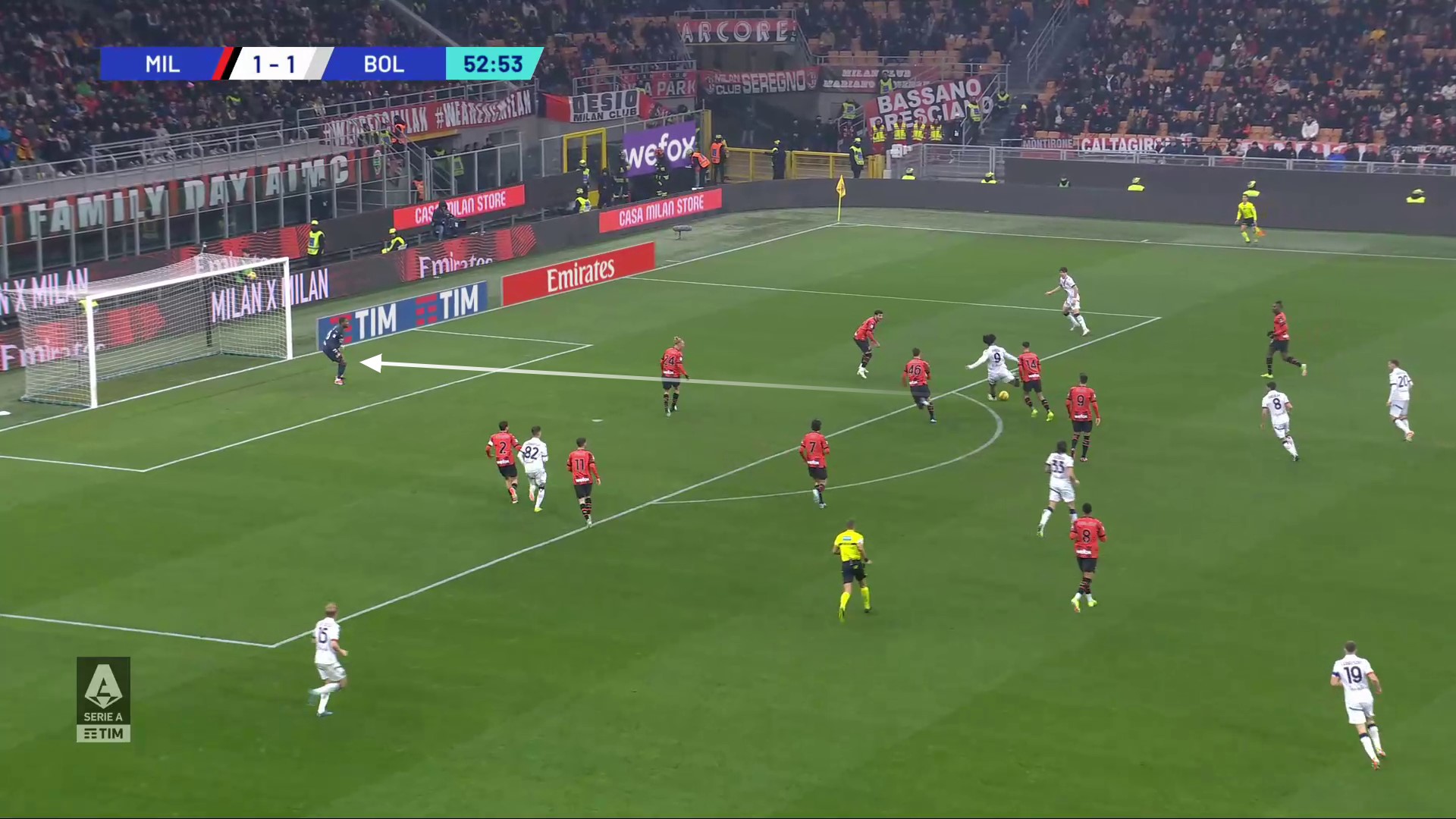
Calafiori presence in attacking areas was nowhere more valuable though than the lead up to Bologna’s penalty award in the 89th minute.
With the away team pushing an equaliser, we’ll pick up the play with a crossfield pass by Bologna which got cut out by a Calabria header. As you can see, Milan had all ten outfield players behind the ball, and Calafiori is where you would ordinarily expect a centre-back to be, outside of the opposition block supporting play.
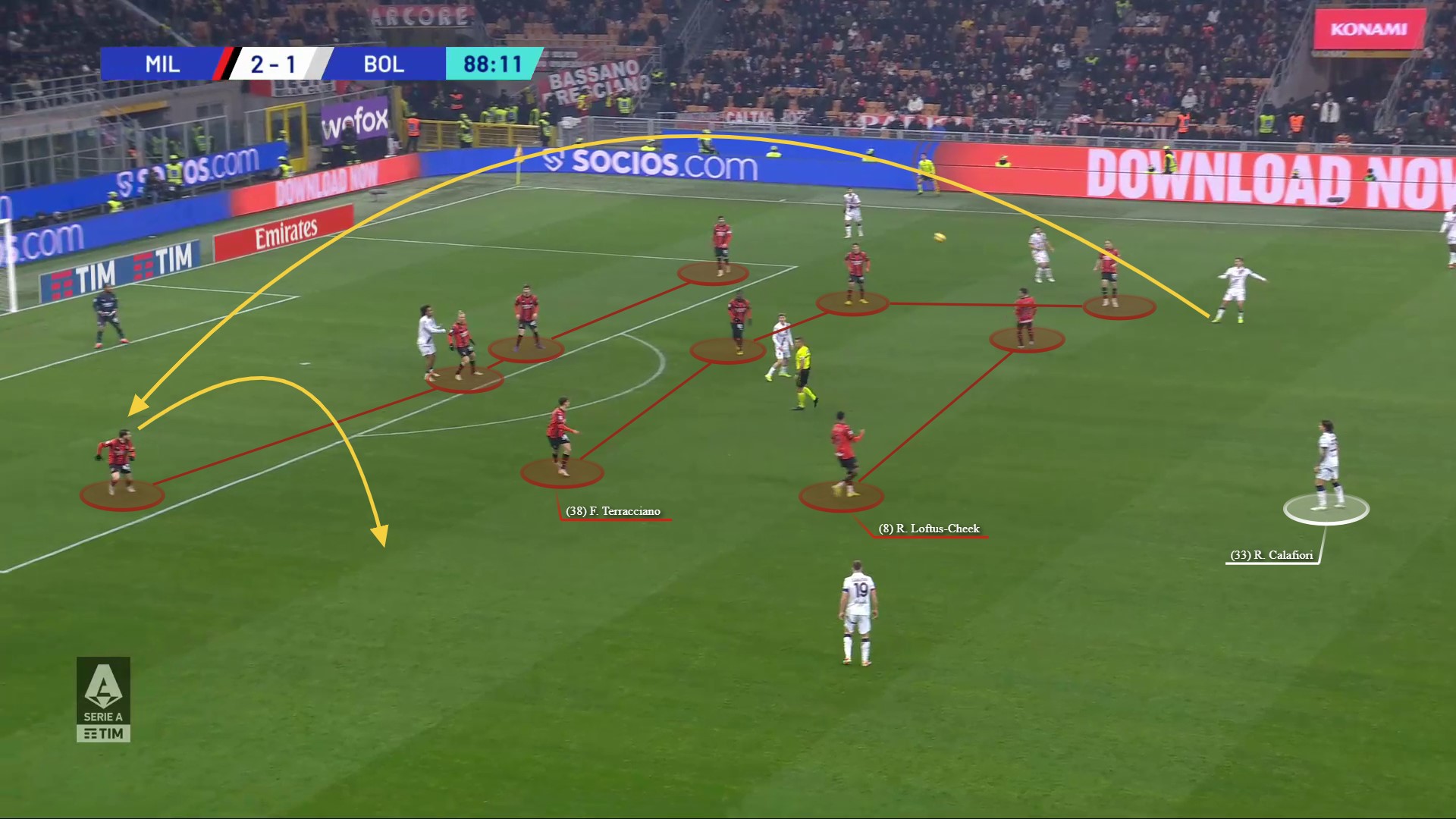
Milan actually won the loose ball from Calabria’s header, but a lack of or mis-communication between Loftus-Cheek and substitute Filippo Terracciano resulted in the two colliding and the hosts turning over the ball.
After Bologna regained they passed out wide and, as highlighted below, Calafiori began to step forward. A quick observation to make here is how the Milan players all quickly locked onto an opponent, but not the Bologna centre-back.
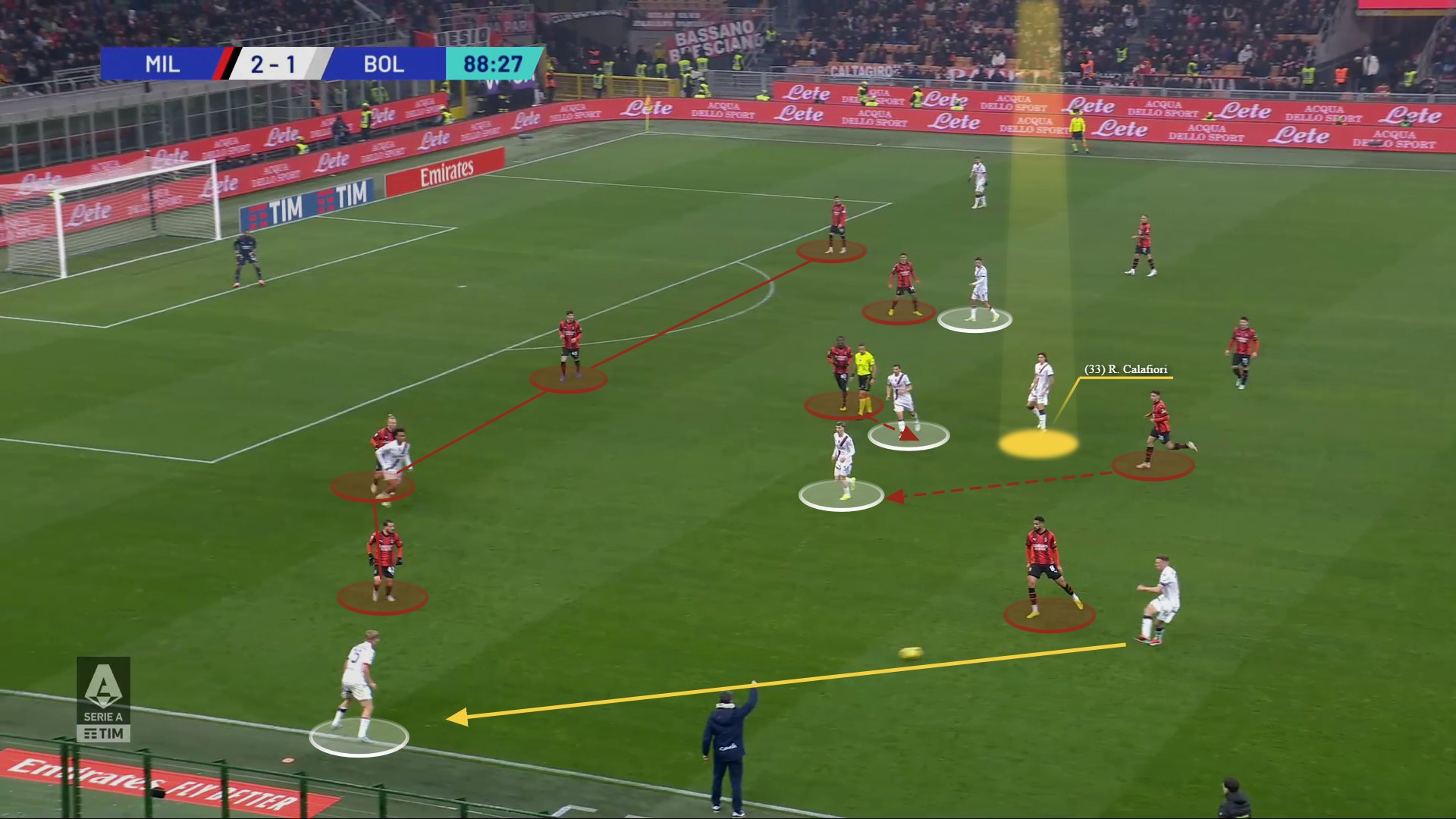
After exchanging passes out wide, Bologna found an opening to play back inside where Calafiori was completely unmarked to receive. Again, not all other Milan players occupied apart from Gabbia who was providing coverage in the backline.

However, seeing Calafiori in space, Gabbia jumped to engage but he could reach in time to effect the play. The outcome, Calafiori passed out to his right winger who then beat Theo Hernández 1v1 before his ‘shot-come-cross’ nearly found Kristiansen at the far post.
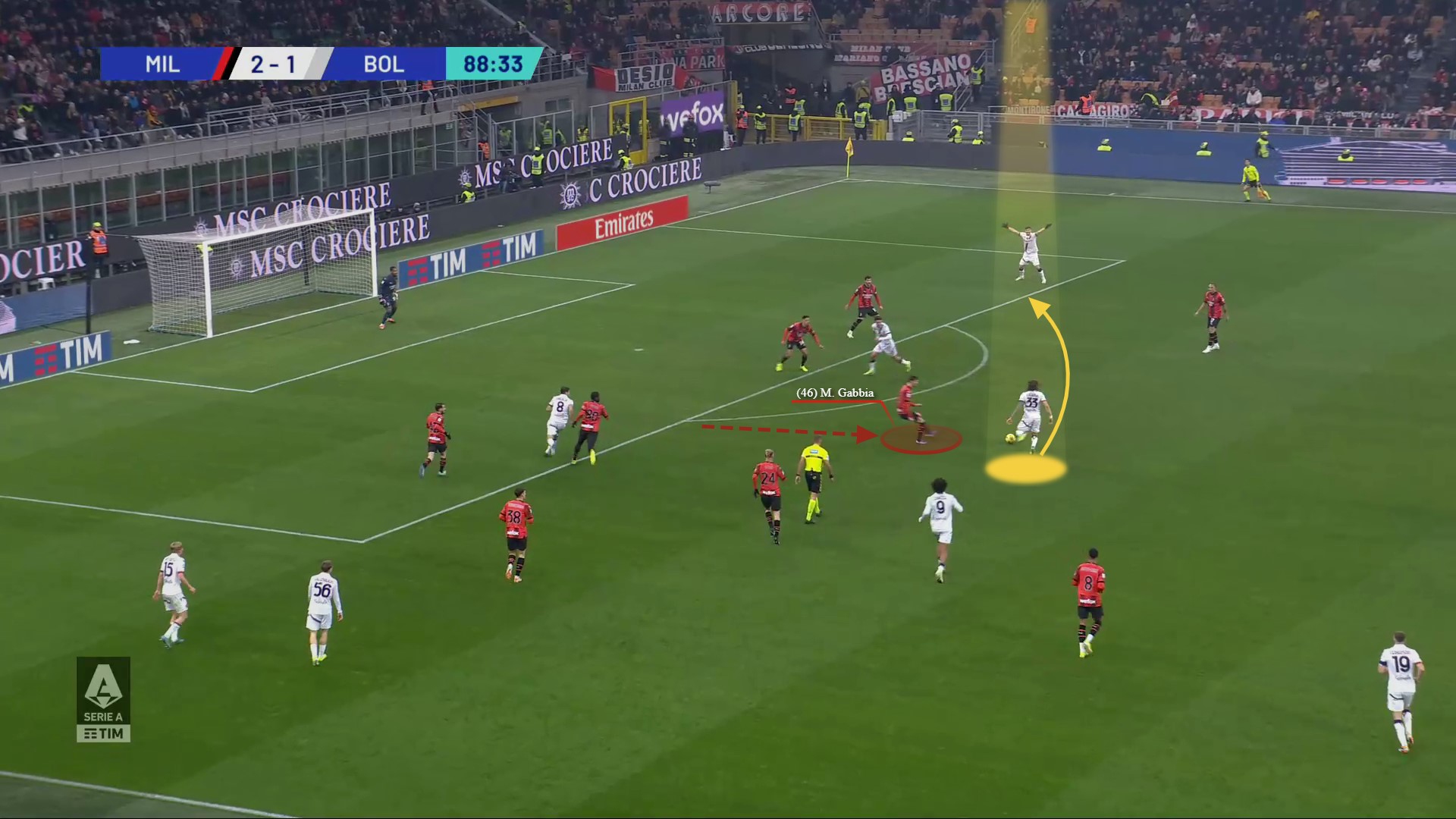
Milan fans will not need or want to see any further screenshots as they know the outcome. VAR ruled that the reason Kristiansen was unable to connect with the aforementioned cross was because his shirt had been pulled by Terracciano, who had been caught by a late-run on his blindside.
Post-match, Pioli complained about his side’s defending in this situation, stating: “We were ten players inside the area and we didn’t help Theo in doubling his man and we didn’t read the cross well.”
Whilst that may be true, another factor worth considering is a reason Theo Hernández had no cover was because his left centre-back partner, Gabbia, had been pulled out of position by closing down the opposition’s attacking centre-back.
As all of the provided match examples have demonstrated, Bologna did find success in regularly progressing the ball upfield using their build-up principles. And whilst the same ‘success’ was not always achieved in entering, and then creating threat, in the final third, the away side’s unique tactic of their centre-backs advancing forward did have a major impact in the game and ultimately securing Bologna a point.
From a Milan perspective, the records will show they conceded two goals (for the second game running), and allowed 14 shots against which totaled a expected goals against of 2.66 (Wyscout). But for context, one of the goals conceded was a penalty and three of their fourteen shots conceded all happened in the same attack during the oppositions first goal.
Plus, considering how much Bologna’s build-up and rotations aimed to destablise their defensive system, Milan limited their exposure with their players constantly adjusting and retreating when required. Although, the Bologna players lacking the required quality in certain actions was equally a factor in this.
One final consider, is how the Rossoneri benefitted from exploiting the downsides of Bologna’s style of play (all tactical plans have them). Namely creating threat in attacking transitions against disjointed Bologna structures – as illustrated in numerous examples above and most vividly in the Leão solo counterattack that led to the award of the second penalty.
But counterattacks were not Milan’s only attacking weapon against Bologna…
Milan’s right wing attacks
In the week leading up to the match, Motta referenced one strength of Milan’s: “Their left wing is very strong, we will try to limit them.”
So it was therefore coincidental (or perhaps intentional) that in fact, Milan focused a lot of their attacking play down their right wing against Bologna – and to much success.
Without the ball, Bologna dropped into a 4-1-4-1 mid-to-low block that allowed Milan possession into the middle third, but engaged in unison once play reached their half. A key feature of how the visitors system pressed the ball was the ball-side central midfielder (Ferguson and Aebischer) jumping up to engage the Milan player on the ball.
For Milan, Pioli’s used similar principles as against Udinese, but their full-backs each had more license to get forward and occupy spaces within the forward line with one of the Milan double pivots, Adli and Reijnders, then pulling out wide to fill the vacant full-back slot.
Here’s an example of both teams performing the above descriptions in practice in the 2nd minute.
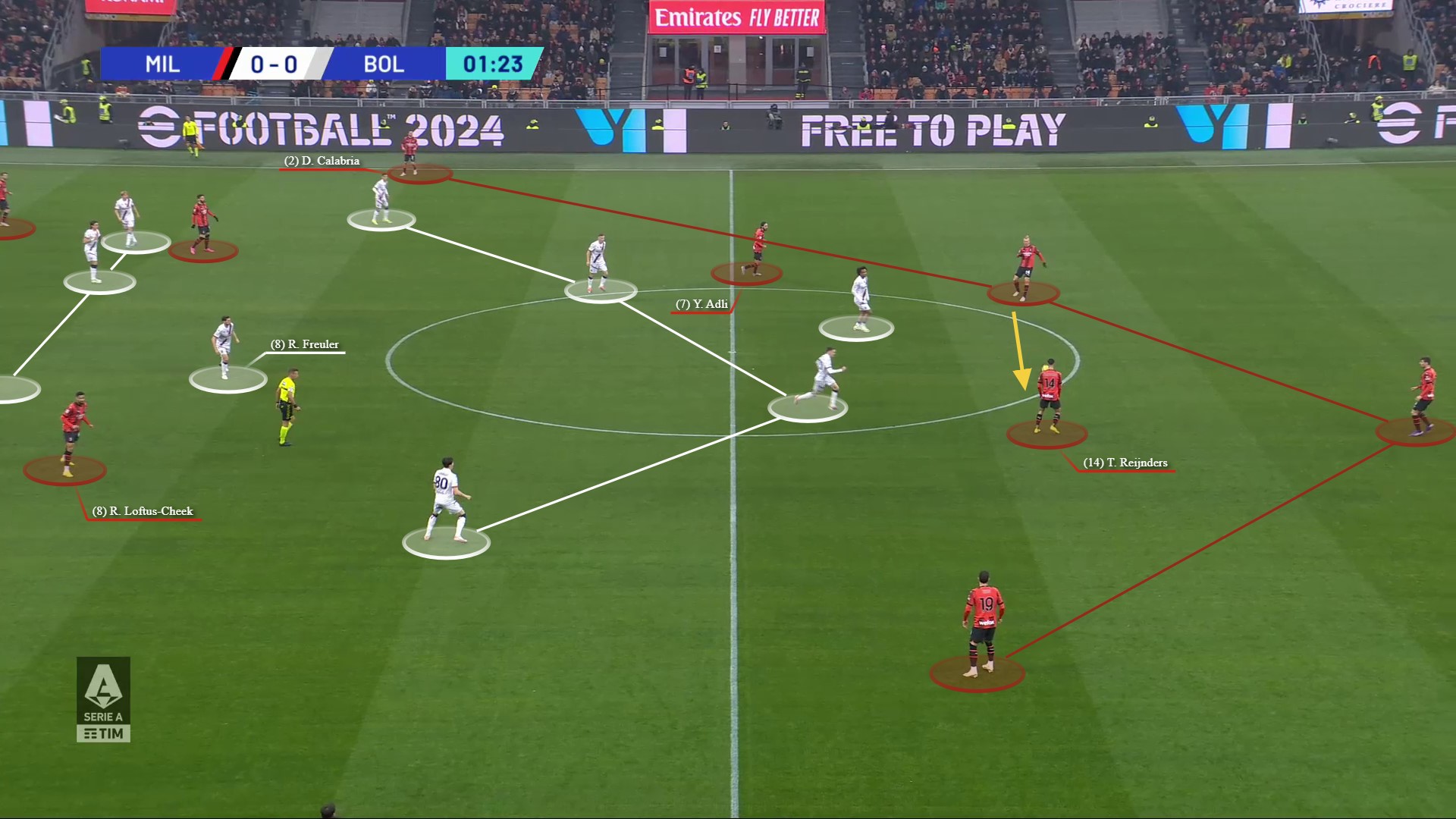
After Adli pulled out into the right-back slot, Calabria’s presence on the right-wing caused Bologna issues which allowed a Giroud flick to find Pulisic running towards goal which required an opposition foul to halt the attack.

Milan constantly looked to use their positional attacks to manufacture attacks down their right wing. In this sequence from the 14th minute, Calabria recognised the vacant space, as a result of the Bologna left-back jumping up to cover Pulisic.
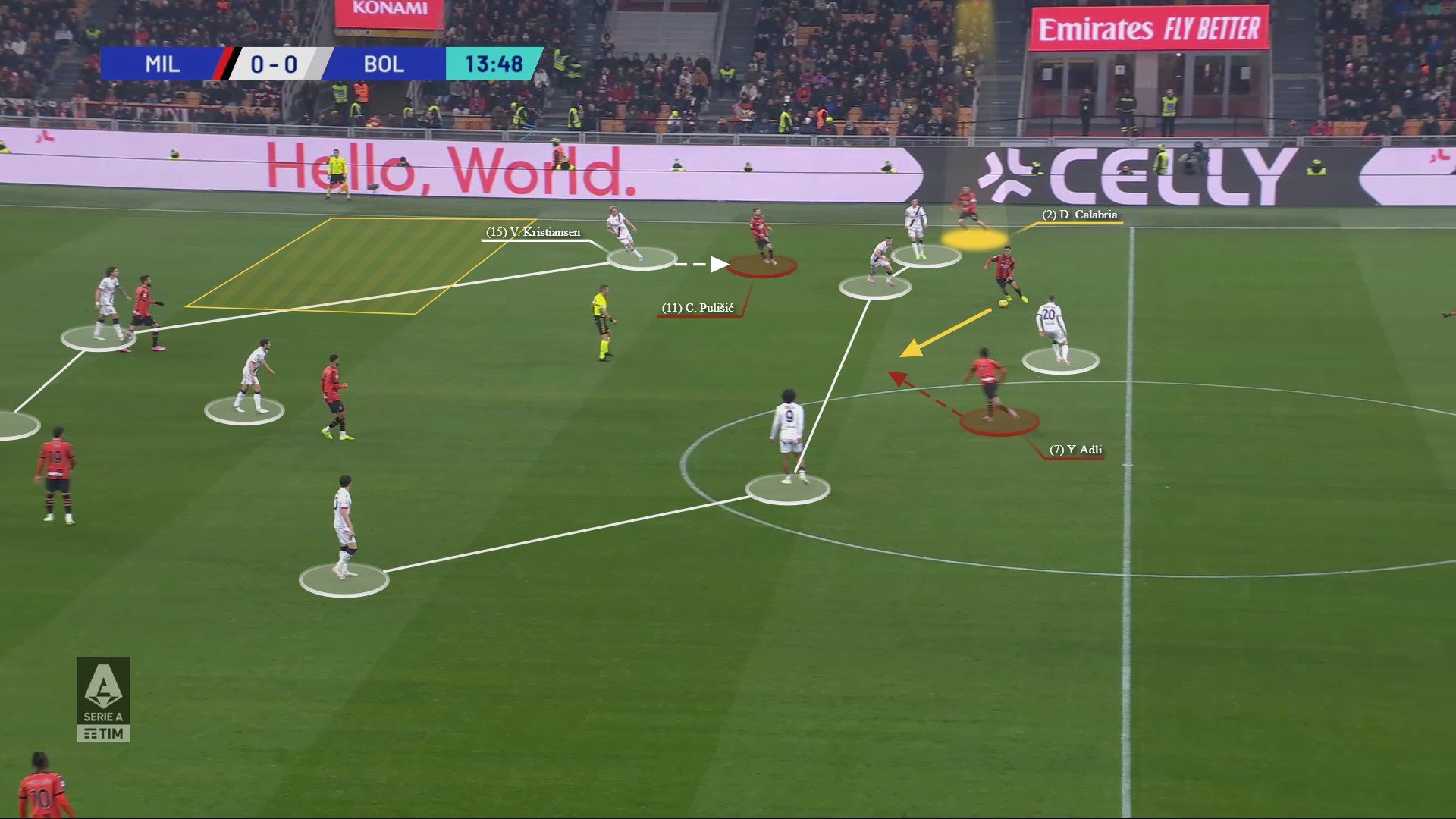
And his blindside run on the Bologna left winger, Urbanski, nearly allowed Milan to access this space but Adli’s pass failed to connect.
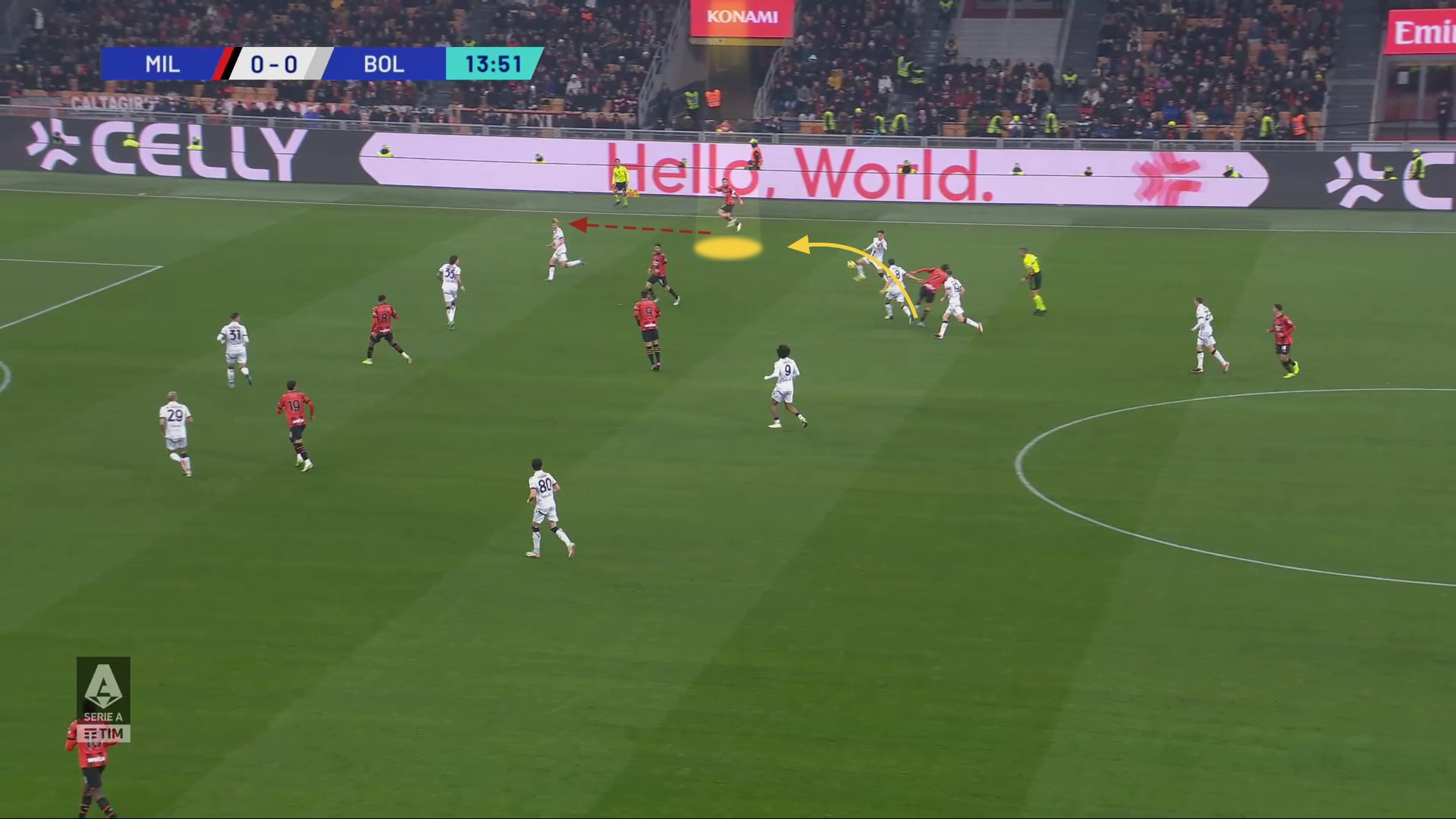
In the 16th minute, there was an example of Calabria advancing into the right half-space. This specific off-ball movement caused Urbanski to completely turn his back to play which created an easy passing lane out to Pulisic.
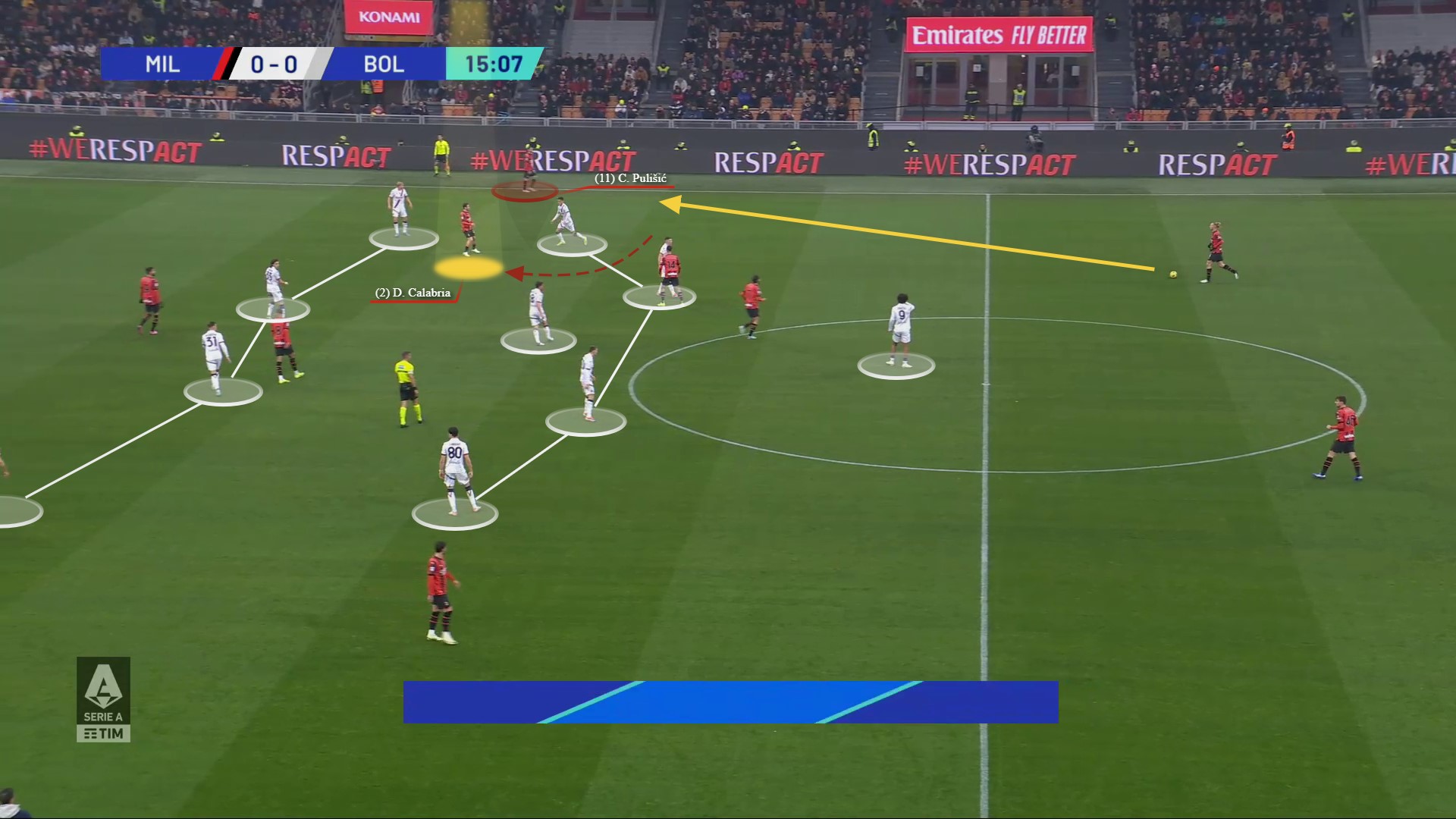
The USA international opted to recycle possession and as a result of the Bologna left-back moving out wide to close down Pulisic, Calabria offered a run in behind for a forward pass from the unopposed Kjær.
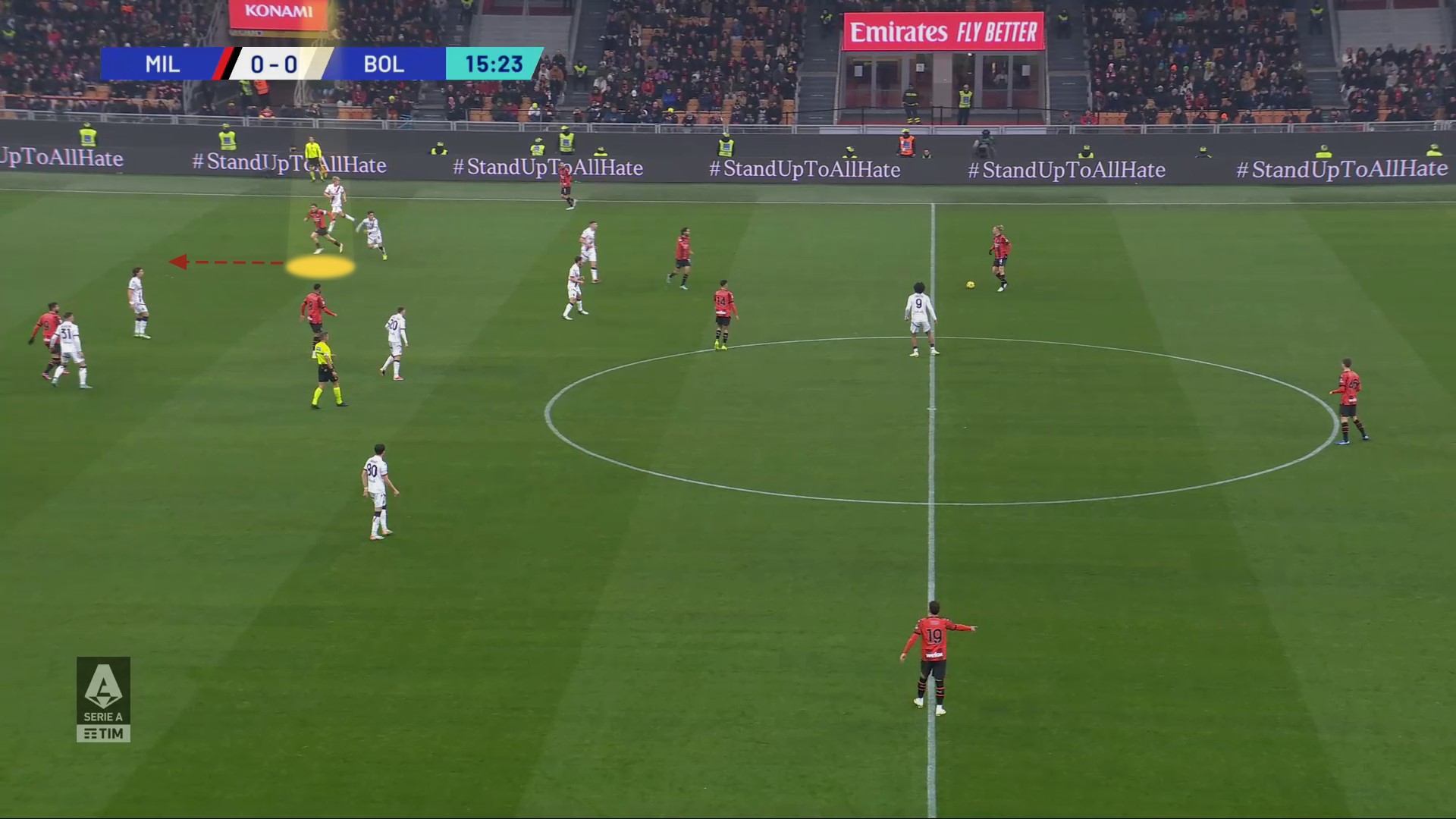
The Danish defender opted against this though and instead went back towards Pulisic out wide. Milan got a slice of fortune with the pass that made its way through, but Calabria – undeterred from his previous unused run – was already looking to attack the space in behind and he won his freekick for his side near the corner flag.

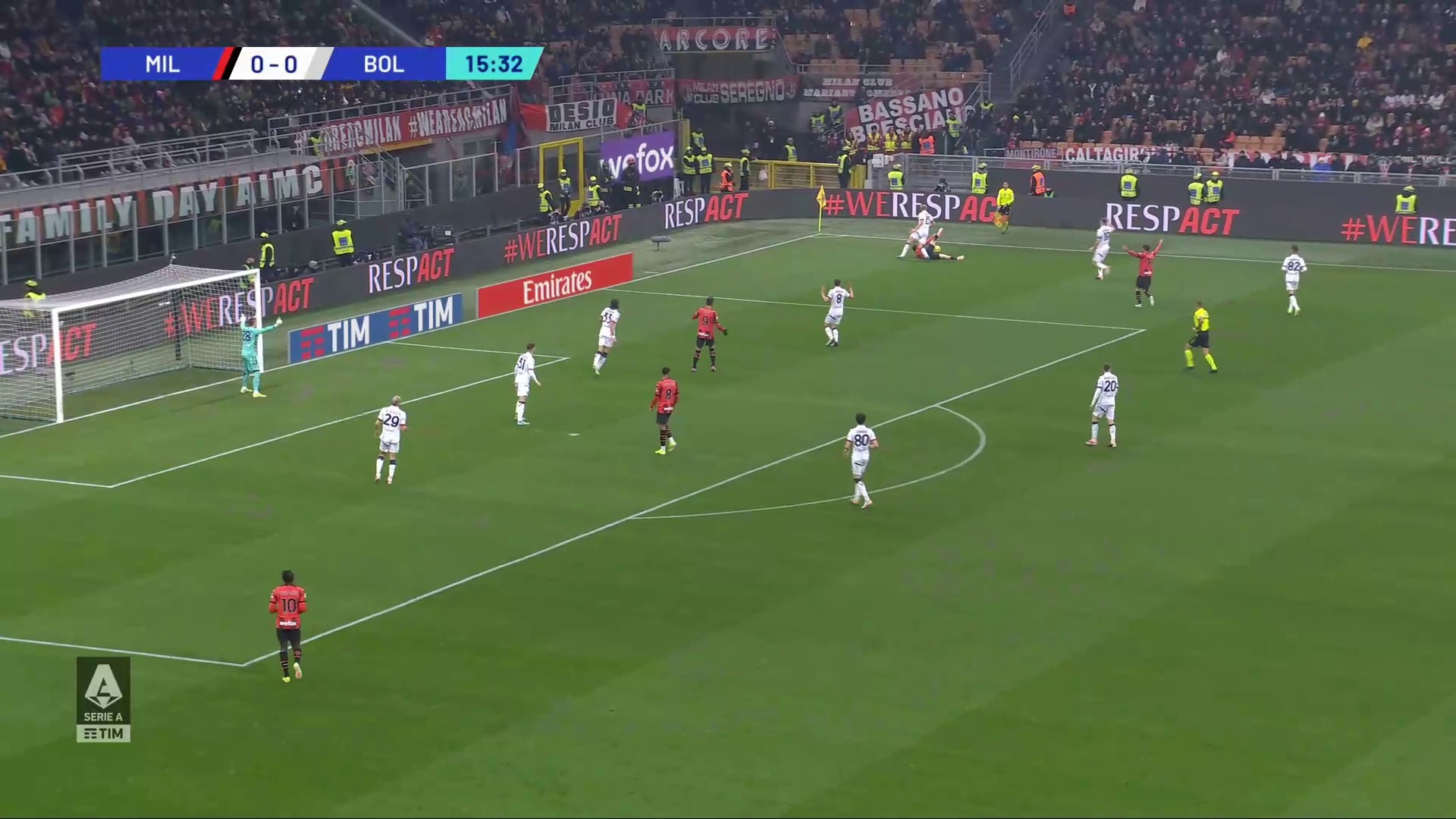
Just shy of the half-hour mark, Calabria’s advanced inversion, inside the Bologna block, created a passing lane out to Pulisic.
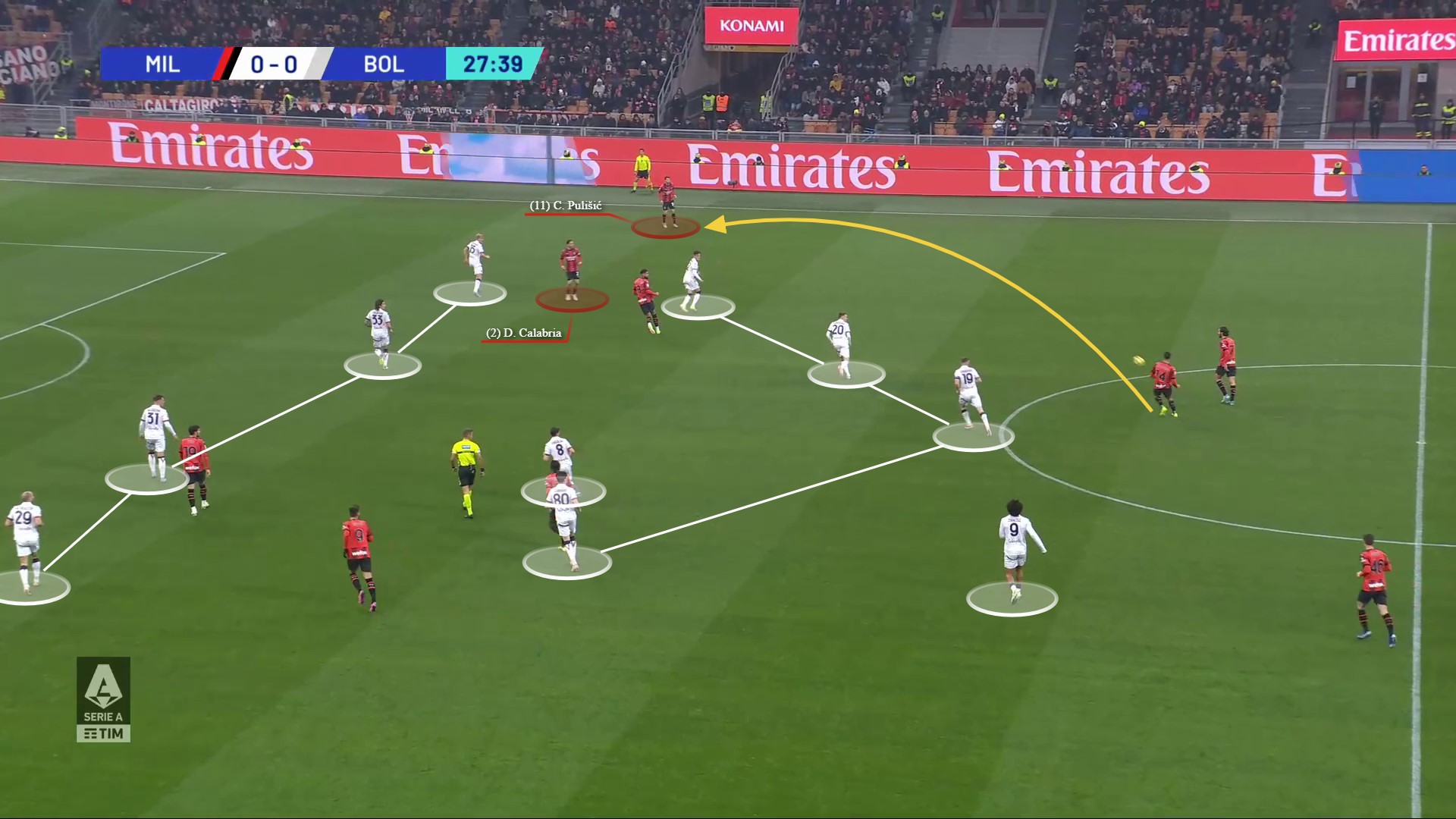
On this occasion, Pulisic executed a one-two with Reijnders to get in behind himself. The space down the line was aided by Calabria’s positioning occupying the Bologna left-back.
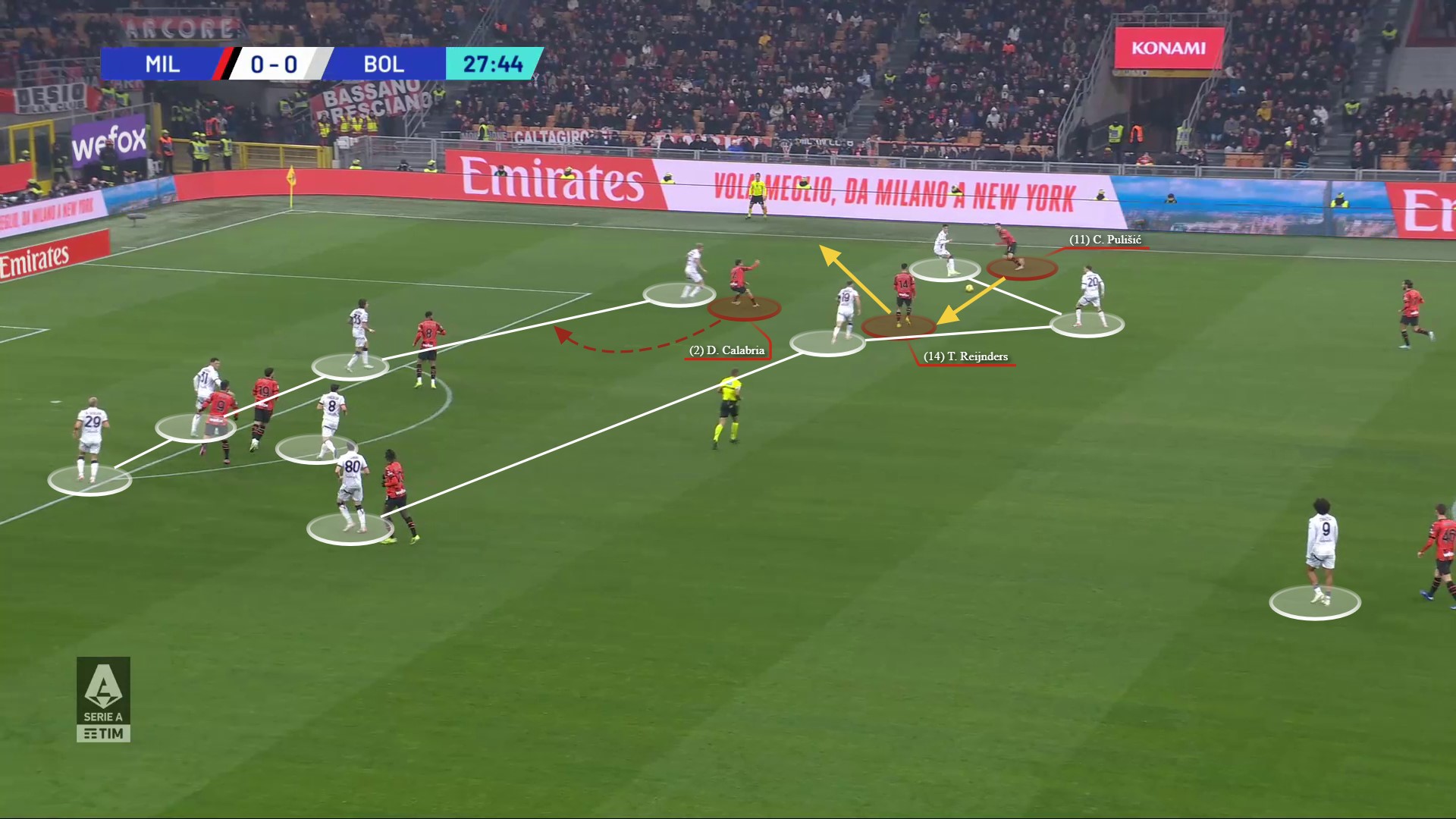
Pulisic’s cross was poor, however, and it was this ball loss which resulted in Bologna springing a counterattack that led to their opening goal.
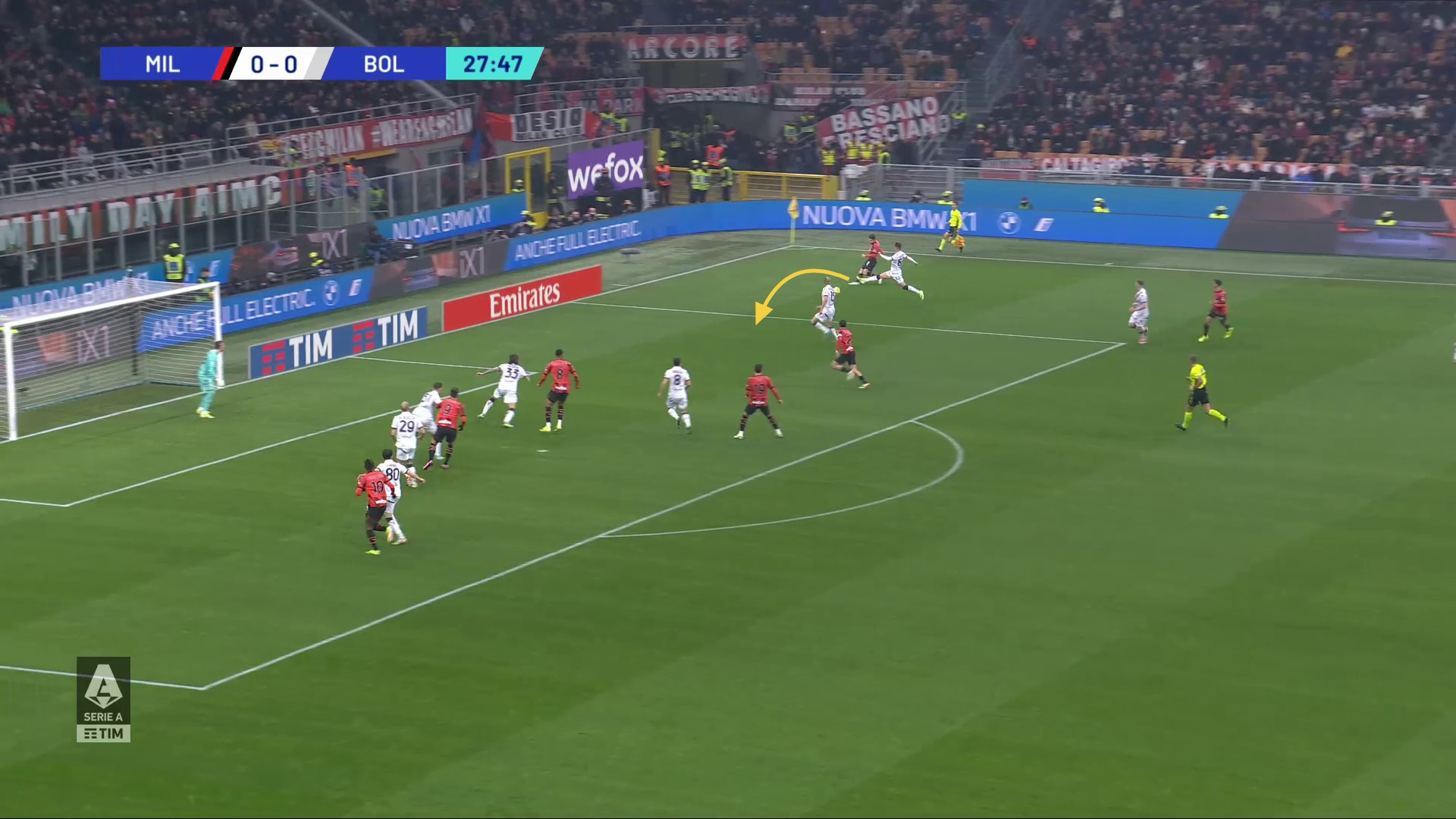
But Milan were level by half-time. And unsurprisingly it came from their right wing. The action picks up below with both Calabria and Pulisic in space and signaling for a pass to be made to the right flank.
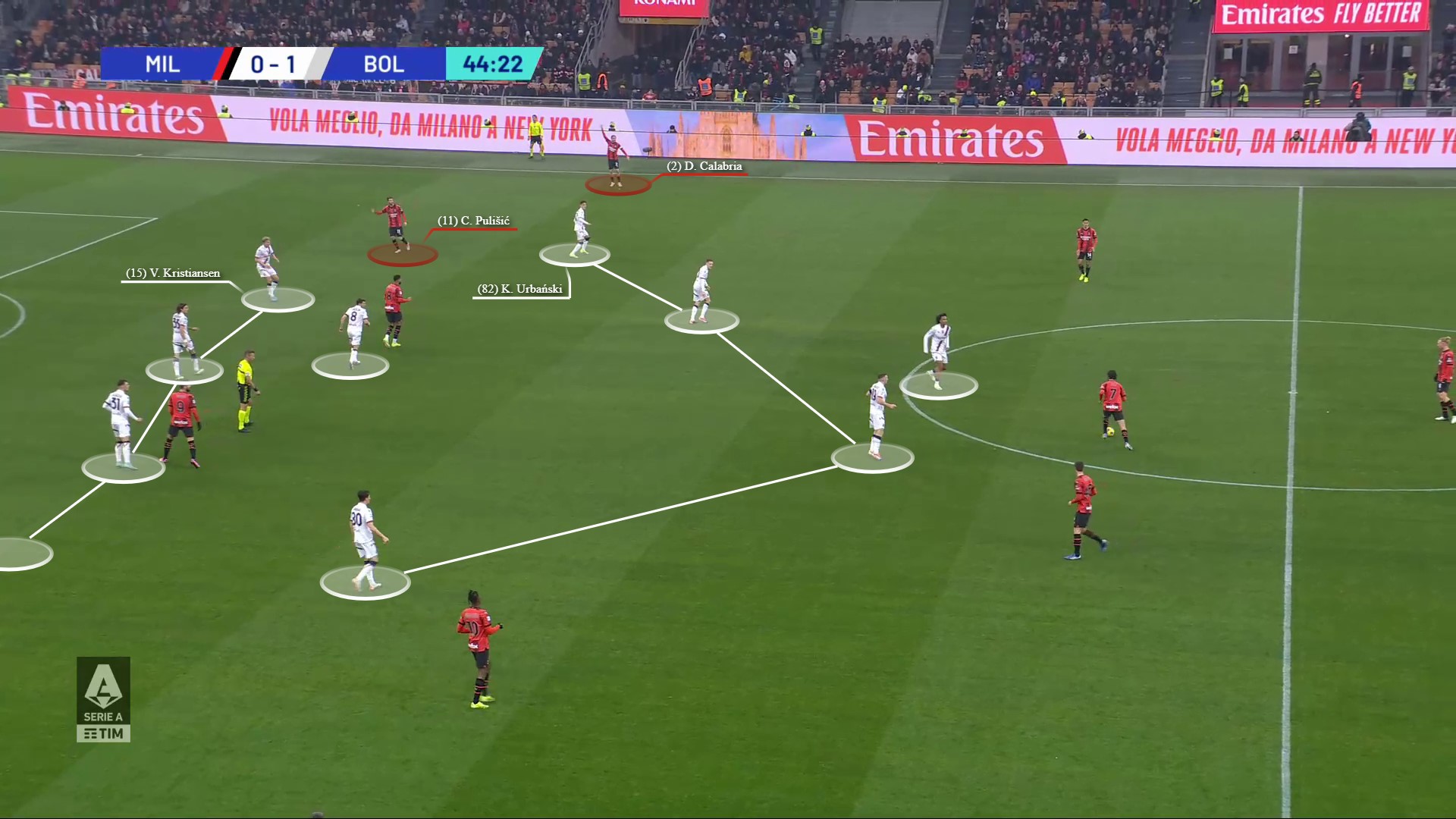
Milan do not go directly to the right wing though, instead passing to Reijnders first who then accesses Pulisic who has dropped towards the ball, attracting the attention of both Kristiansen and Urbanski in the process, leaving Calabria unattended.
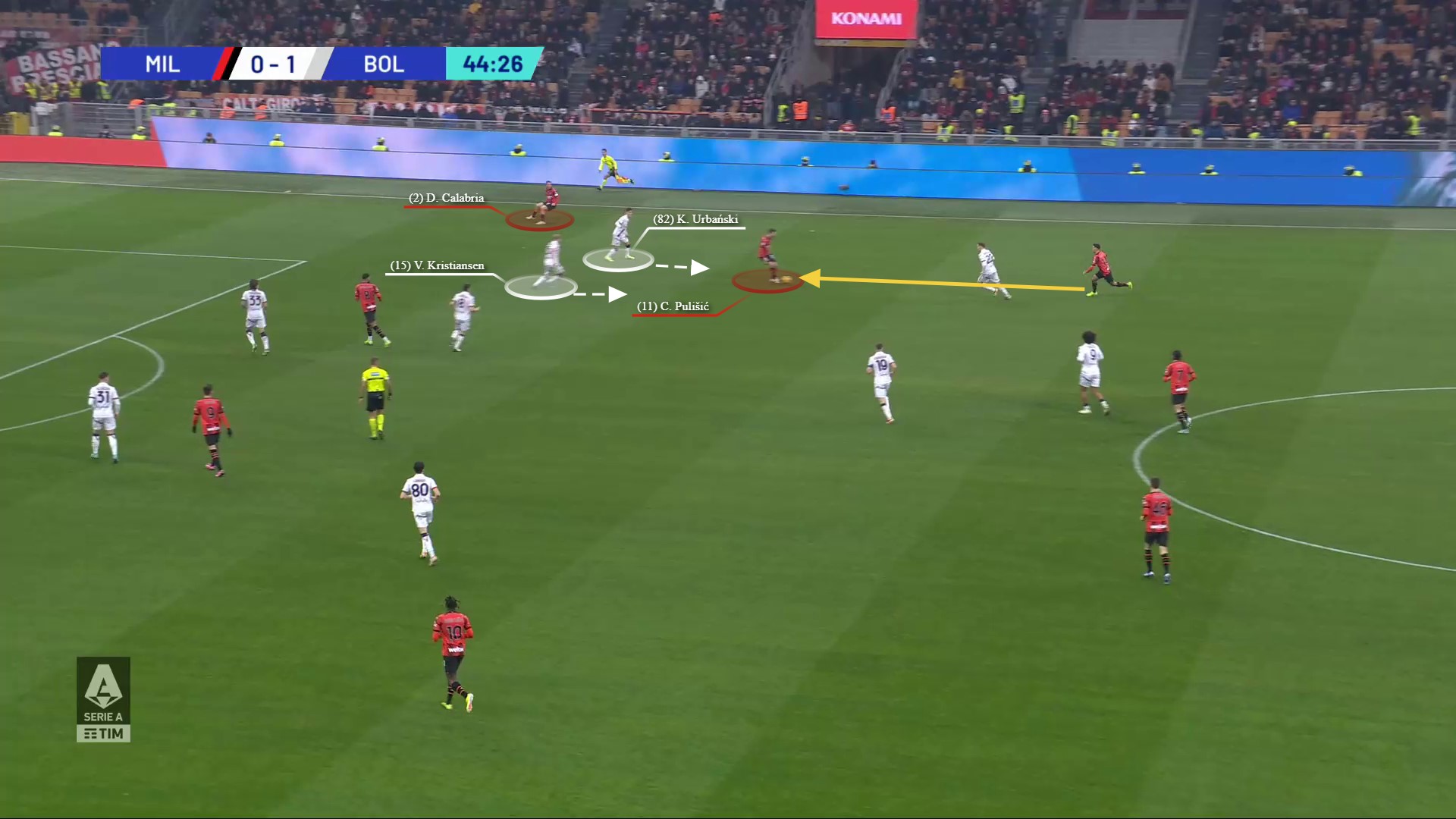
Kristiansen is the one who went to engage Pulisic but Urbanski stayed caught in no man’s land and worse allowed a forward pass on his inside, as opposed to on his outside.
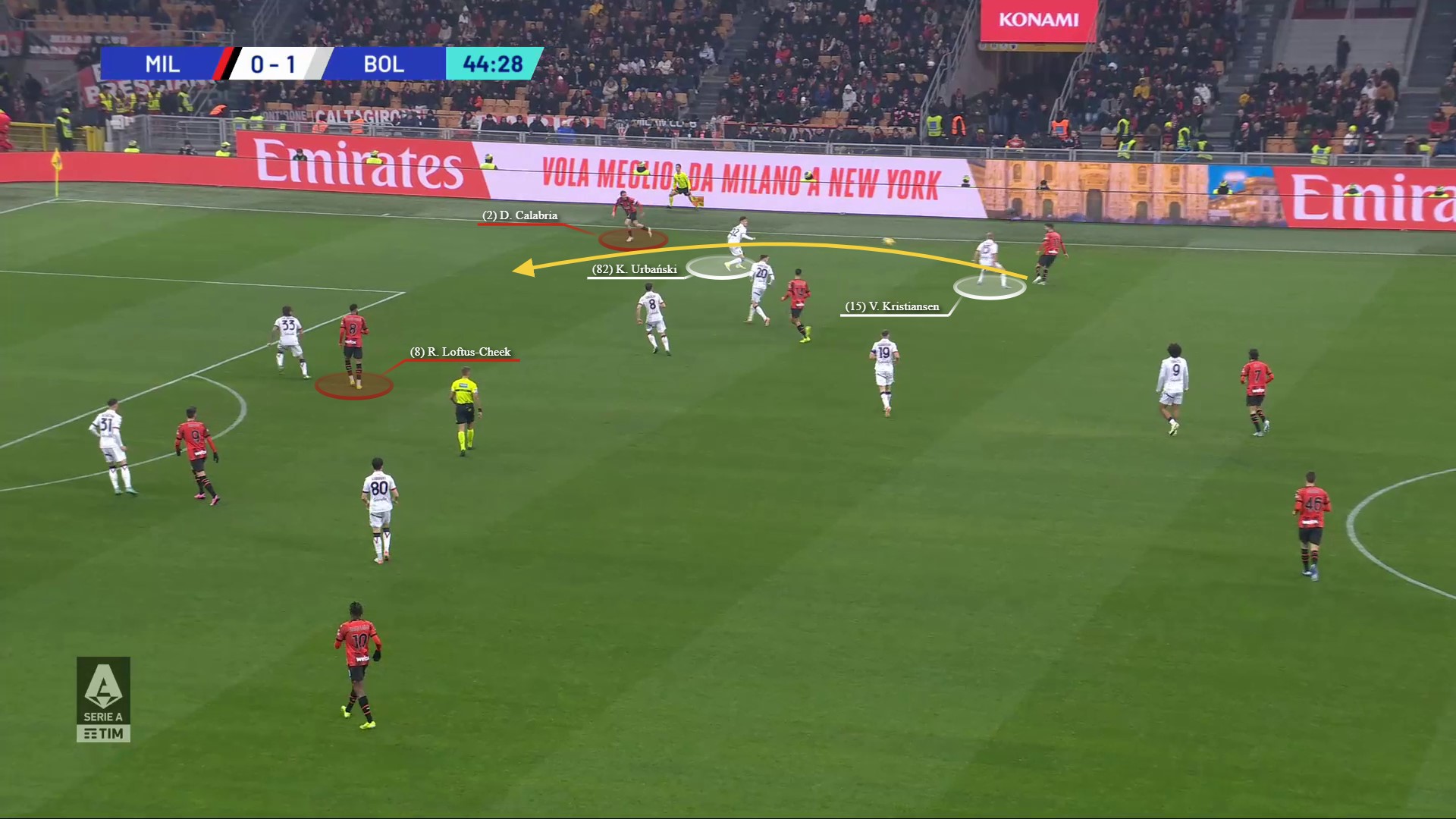
This small detail allowed Calabria’s blindside, out-to-in, run to be diagonal and towards the Bologna penalty area. Calafiori had to push over to engage, vacating Lotus-Cheek as a result, and Calabria was able to find the attacking midfielder to convert.

In the second half, Calabria was substituted on 58 minutes and replaced by Alessandro Florenzi. And whilst Milan’s attacking threat became relatively non-existent in the opening 25 minutes after the interval, they soon got back to their right wing attacks and it played a part in the home side taking the lead in the 83rd minute.
In the preceding sequence to the goal, Bologna were in fact on the attack but lost possession in the final third (a previous flagged recurrence) when Zirkzee’s through ball failed to find Alexis Saelemaekers (substitute for Urbanski).
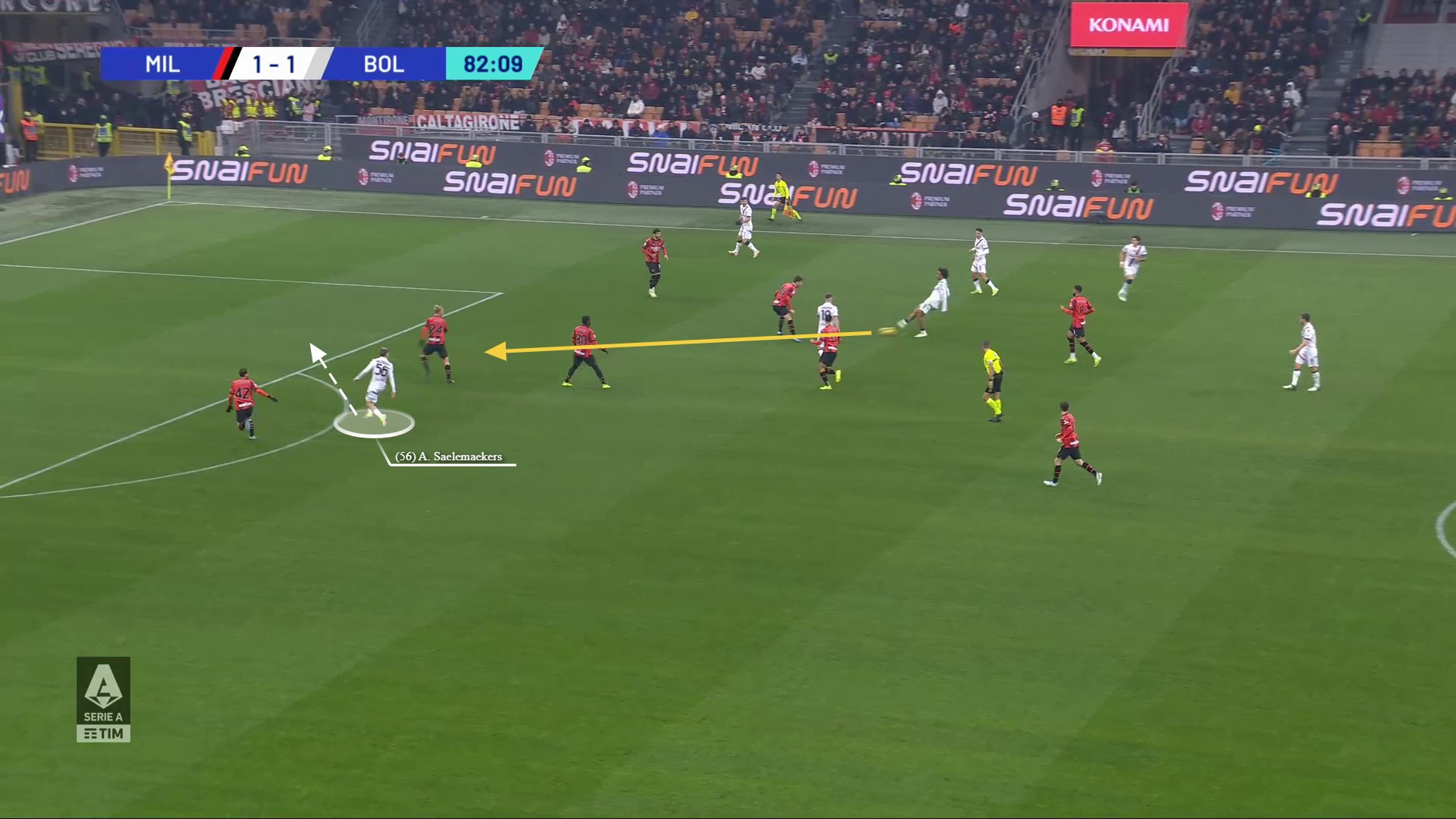
Twenty seconds later, Milan had possession in the Bologna half. The visitors had done well to recover into their 4-1-4-1 shape, including Saelemaekers who was previously the furthest player forward on the pitch.
Florenzi passed to Leão, who was situationally on the right wing from the transitional attack, which triggered Kristiansen to engage (and open up space to exploit).
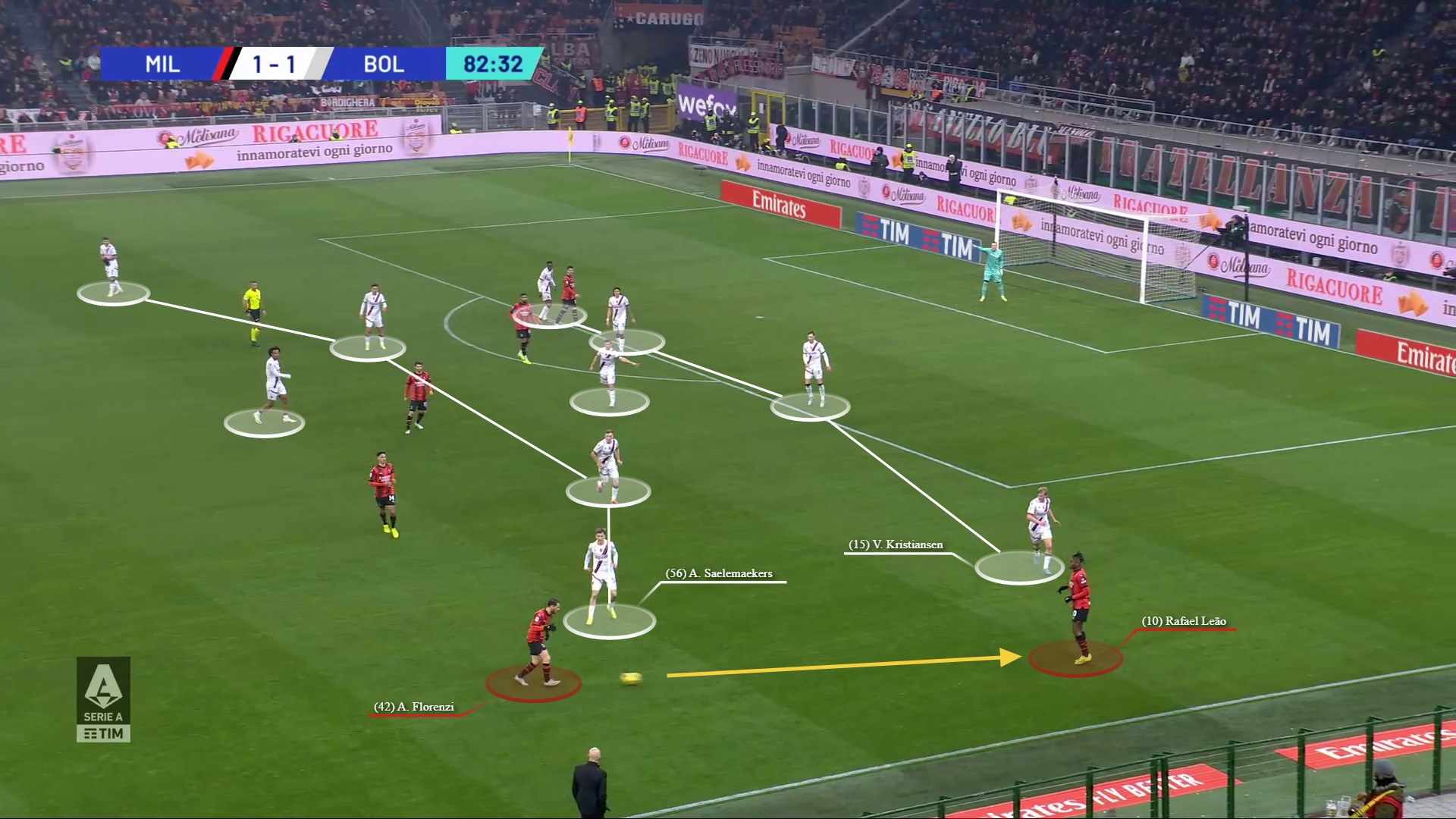
In true Calabria-fashion, after making the pass, Florenzi didn’t hesitate and continued his forward run whereas crucially, Saelemaekers momentarily paused – possibly in fear of Leão cutting inside or still tired from his long distance retreat.
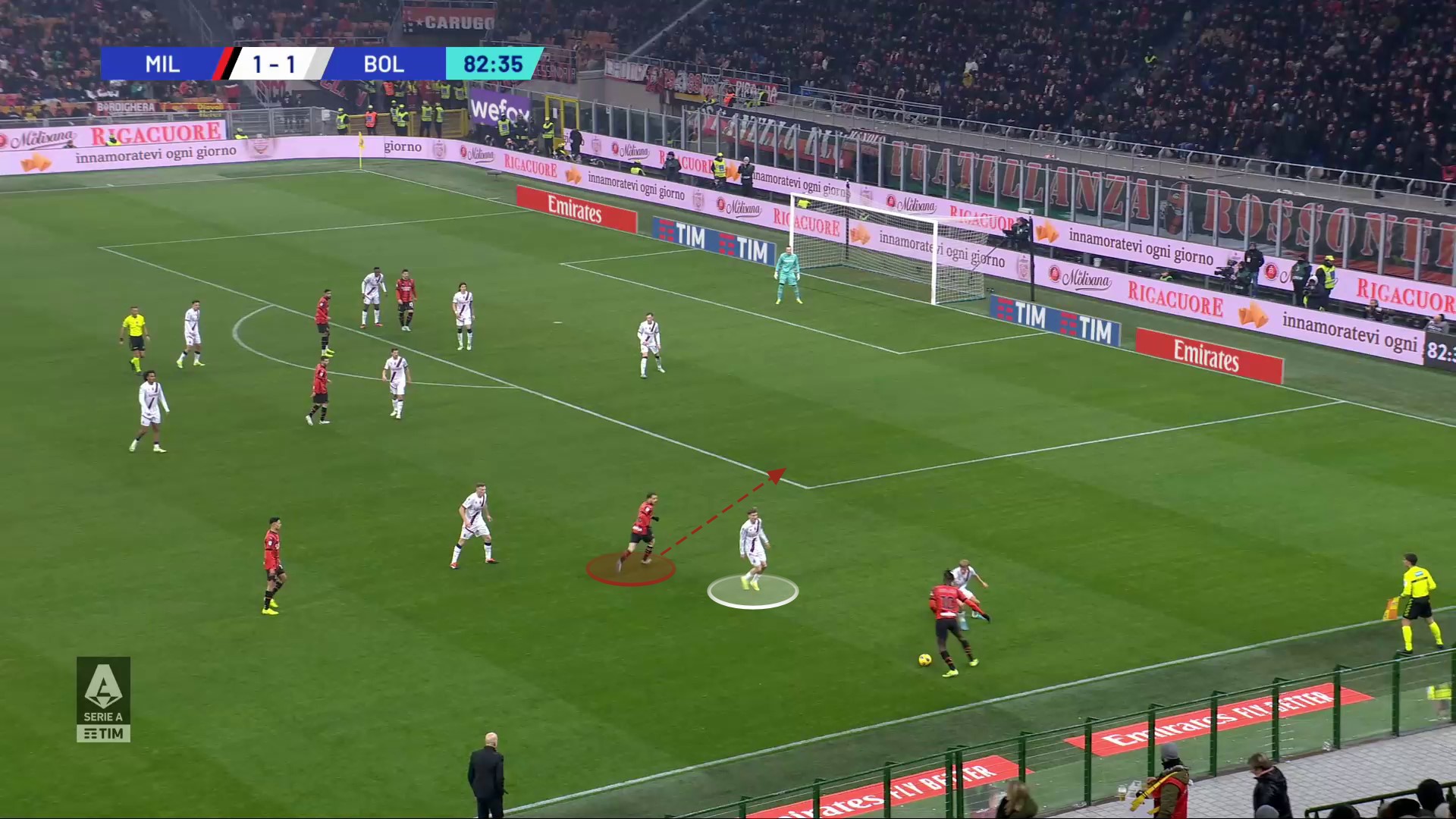
Whatever the reason, Florenzi stole a march on his opponent and was able to receive Leão’s pass at the touchline where he clipped a ball into the box for Loftus-Cheek to head in.
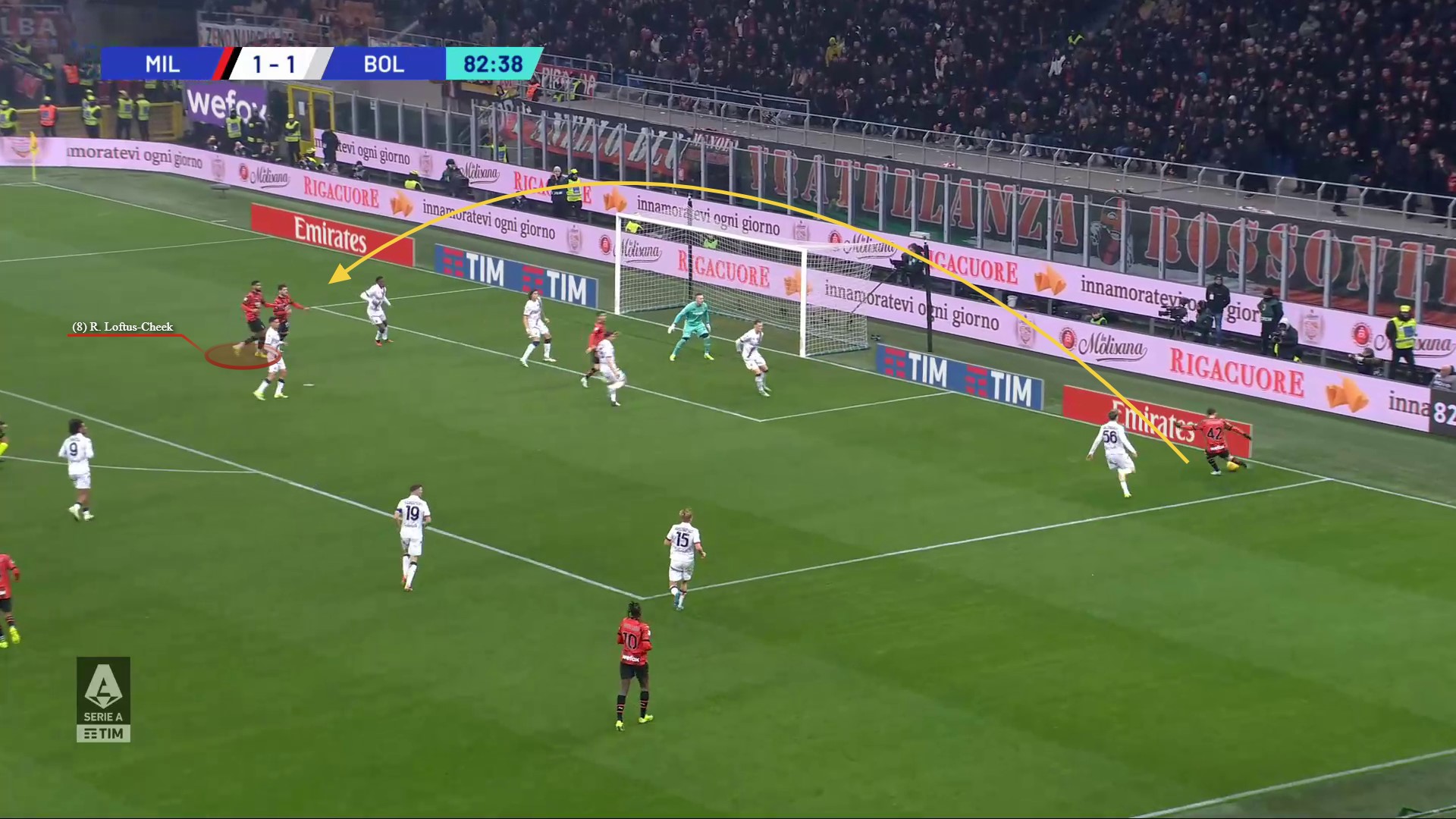
A regretful point
As the final scoreline and match statistics suggest (51%-49% possession in Bologna’s favour, 14 shots on goal apiece, with the list of similar stats going on), this was a relatively even game, with both side’s causing each other issues, as detailed within this piece.
However, the fact that Milan missed two penalties and conceded in the final minutes make this a regretful point. Juventus dropping points this past gameweek only adds to the regret too.

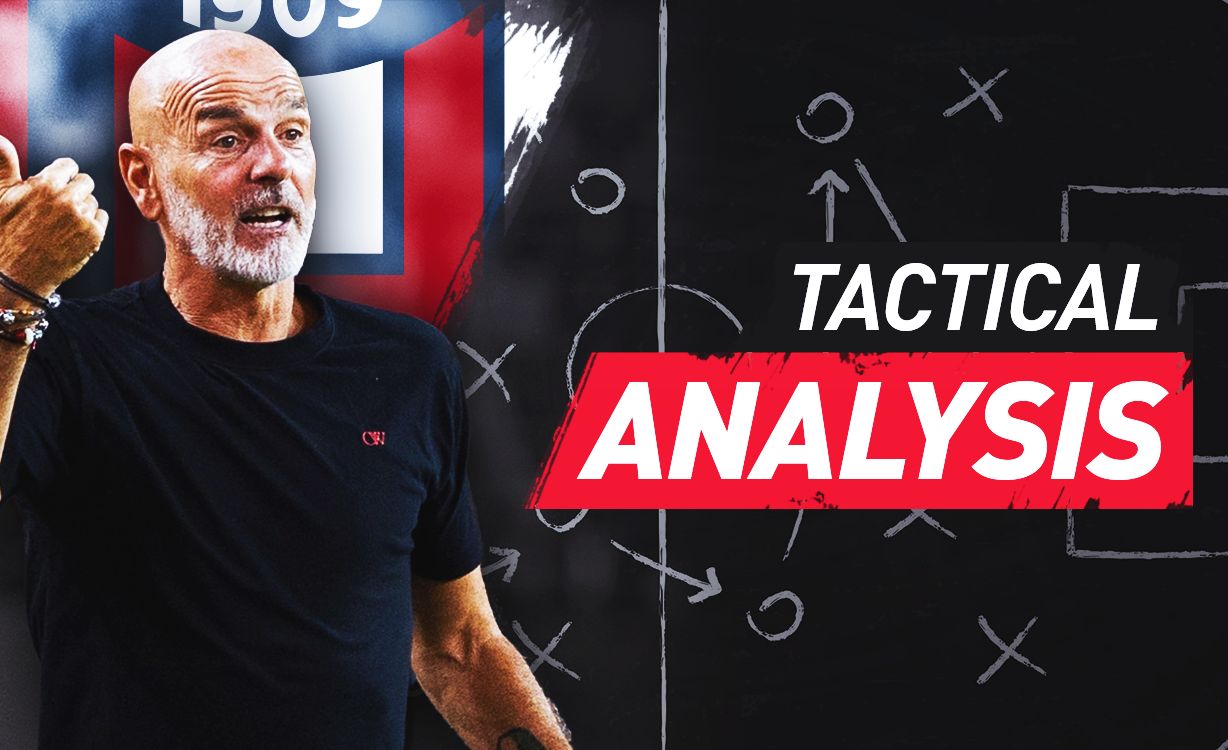
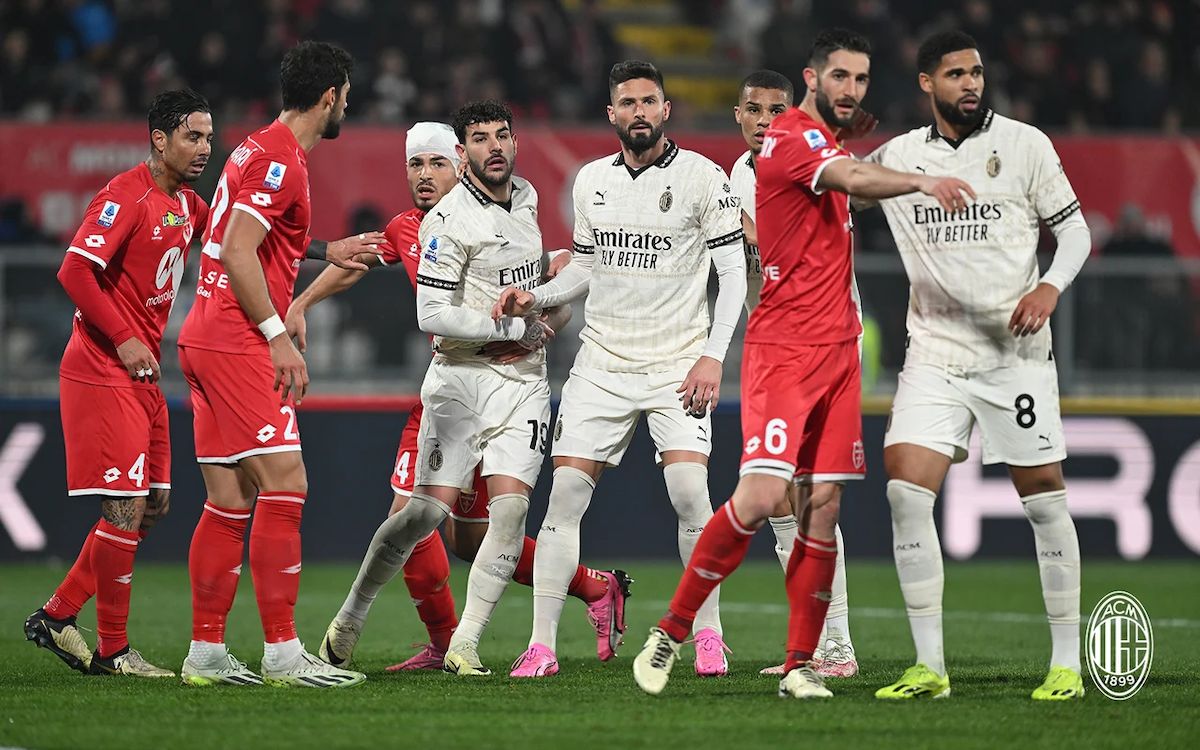
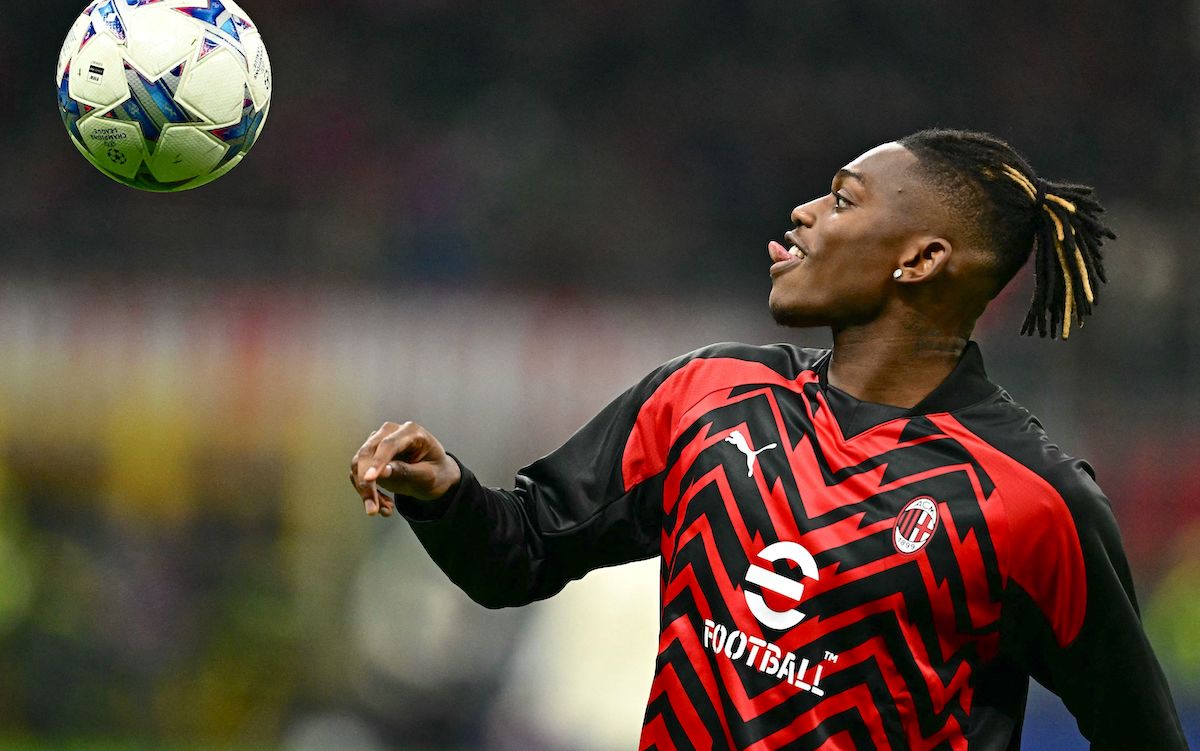


True…but let’s be honest, on another day we’d have won this easily. For all Motta’s amazing possession-based build-up, they’d have lost 4-1 if Maignan hadn’t turned into Dida and we knew how to kick a ball into a net from 12 yards out.
100% true. Milan were not outcoached. Our press gave them all sorts of problems as they clumsily tried to play out from the back. This should have been an easy win. Milan were let down by our veteran players, mostly Giroud, Maignan and Theo, but Leao also missed a sitter and Kjaer missed a free header from 3 yards out. But yeah, let’s blame it all on Pioli. That’s the mindset of some of the fools on here.
And I bet if Maldini were here those guys would have made their penalties. Waiting for that comment to come out of here.
Look, no matter how wasteful we were, we conceded 2 goals again..
Yes, but that’s not on the coach either. For Maignan to get beat near post from that angle is a really bad mistake. And even the penalty probably should have been saved as it was not a good one.
💯. I thought at the time Pioli’s subs were a bit strange but other than that he can’t put on a pair of shorts and score these goals for them.
It’s crazy how Milan have to score 3 or 4 goals to win every match.